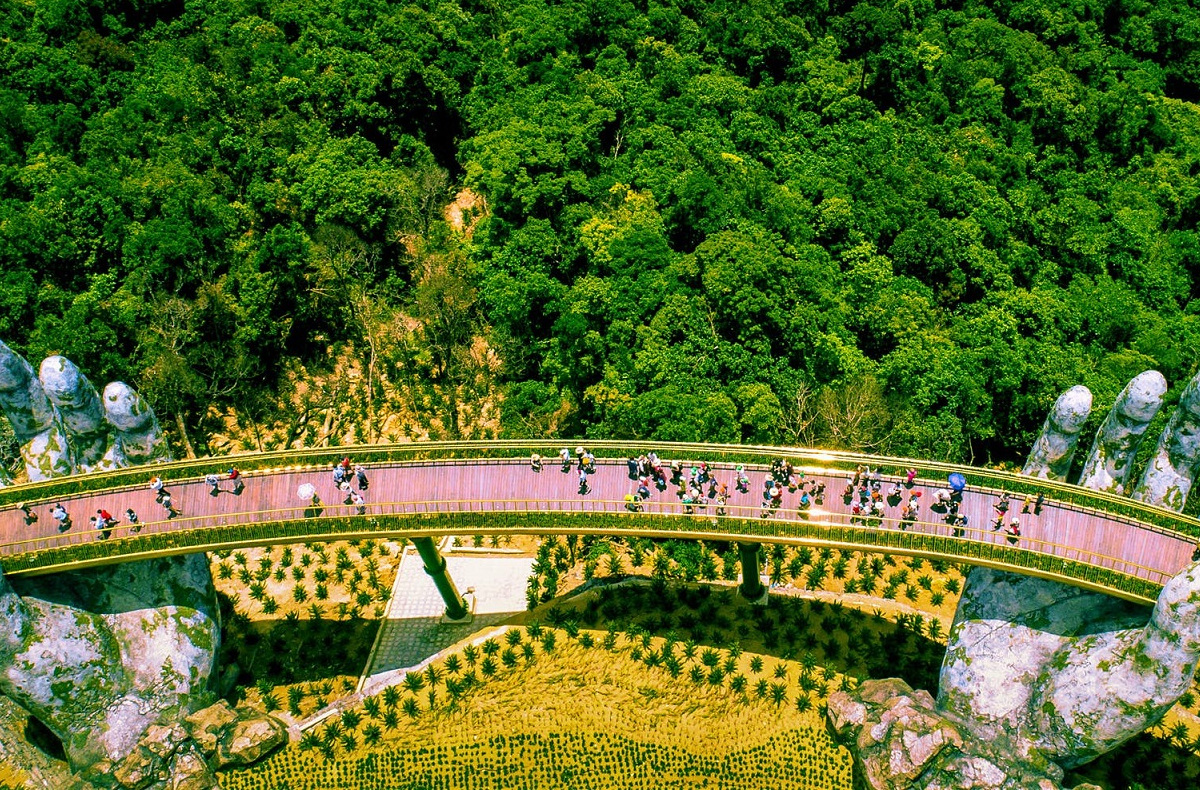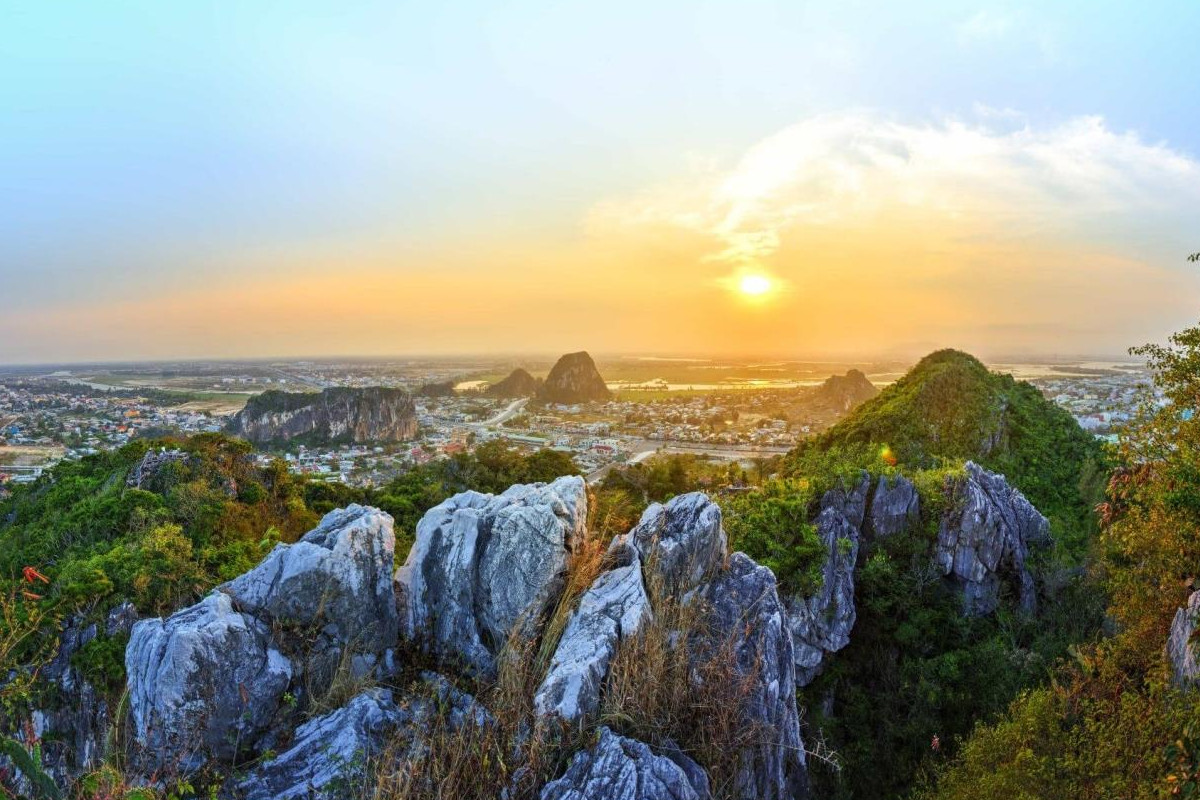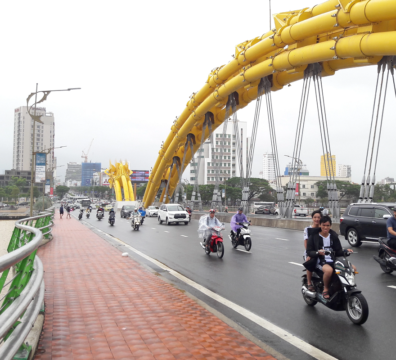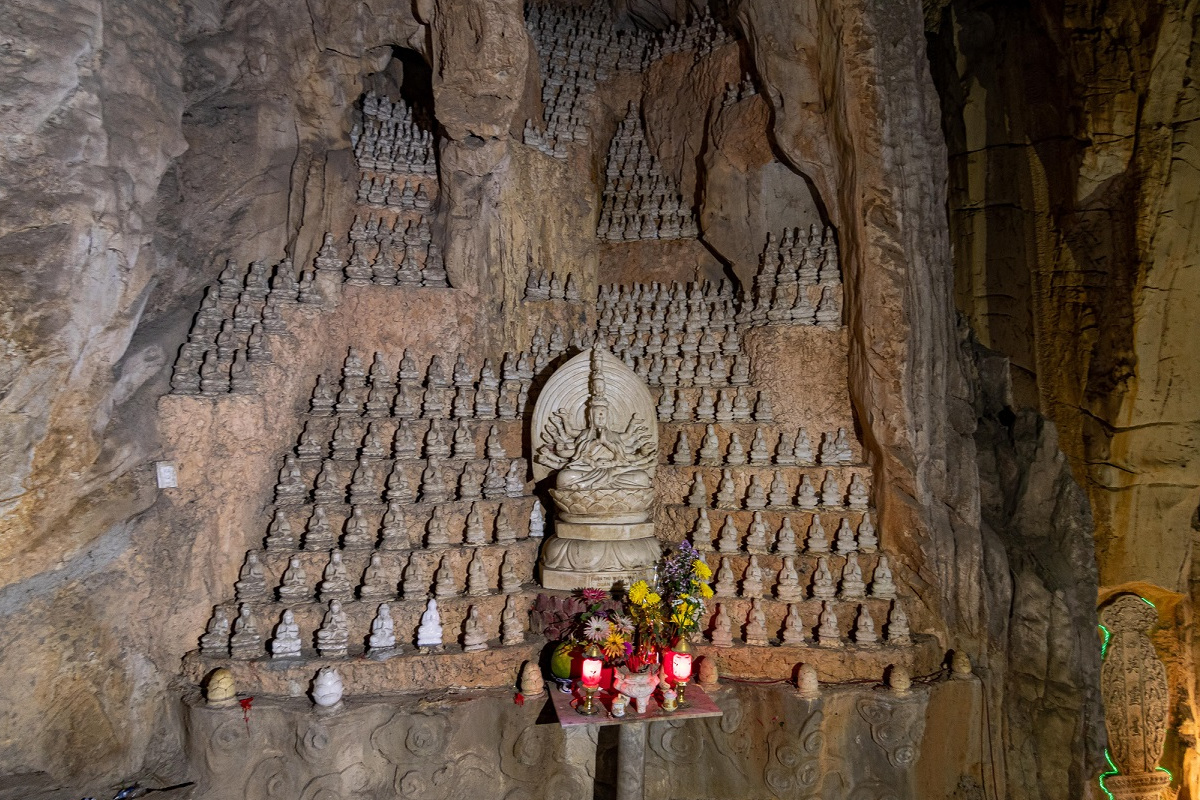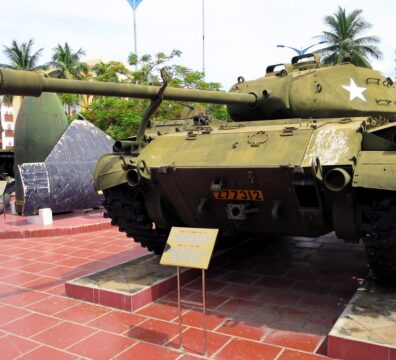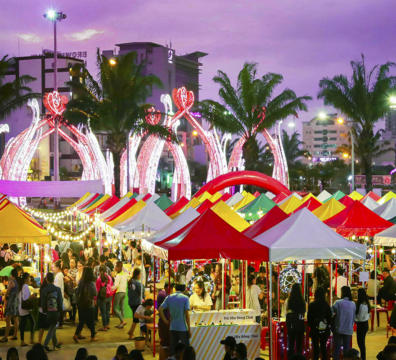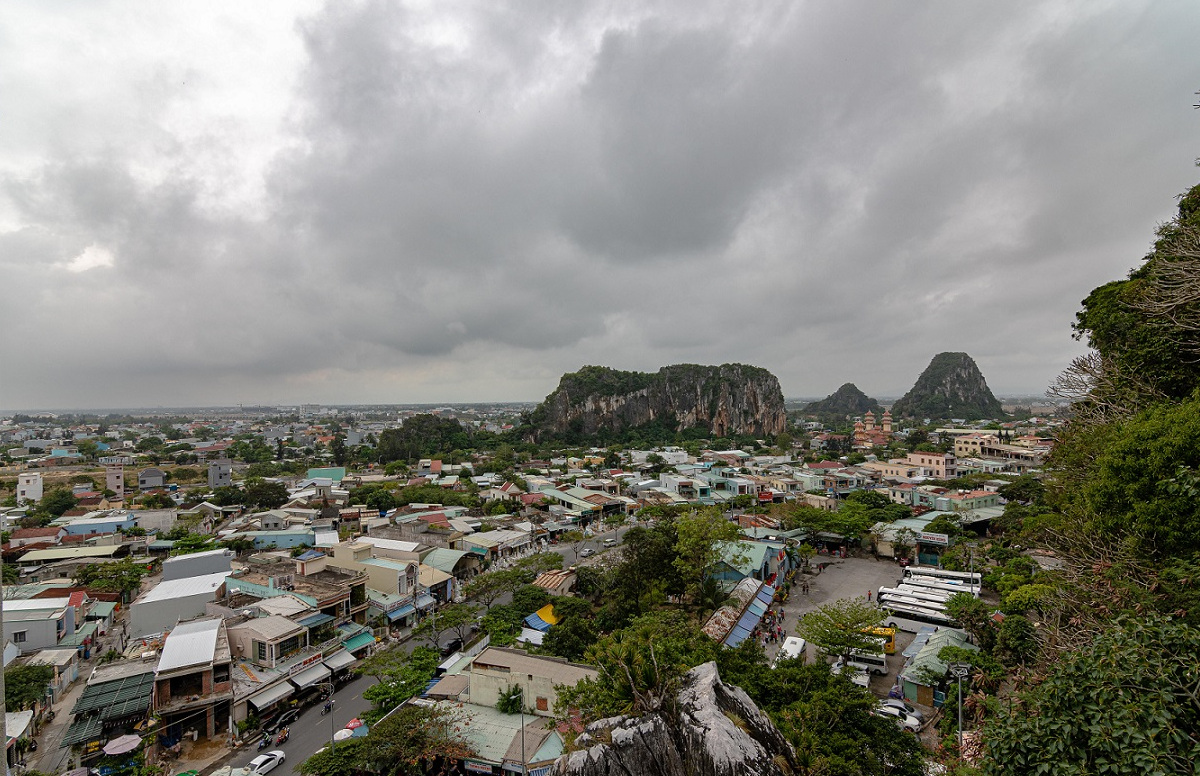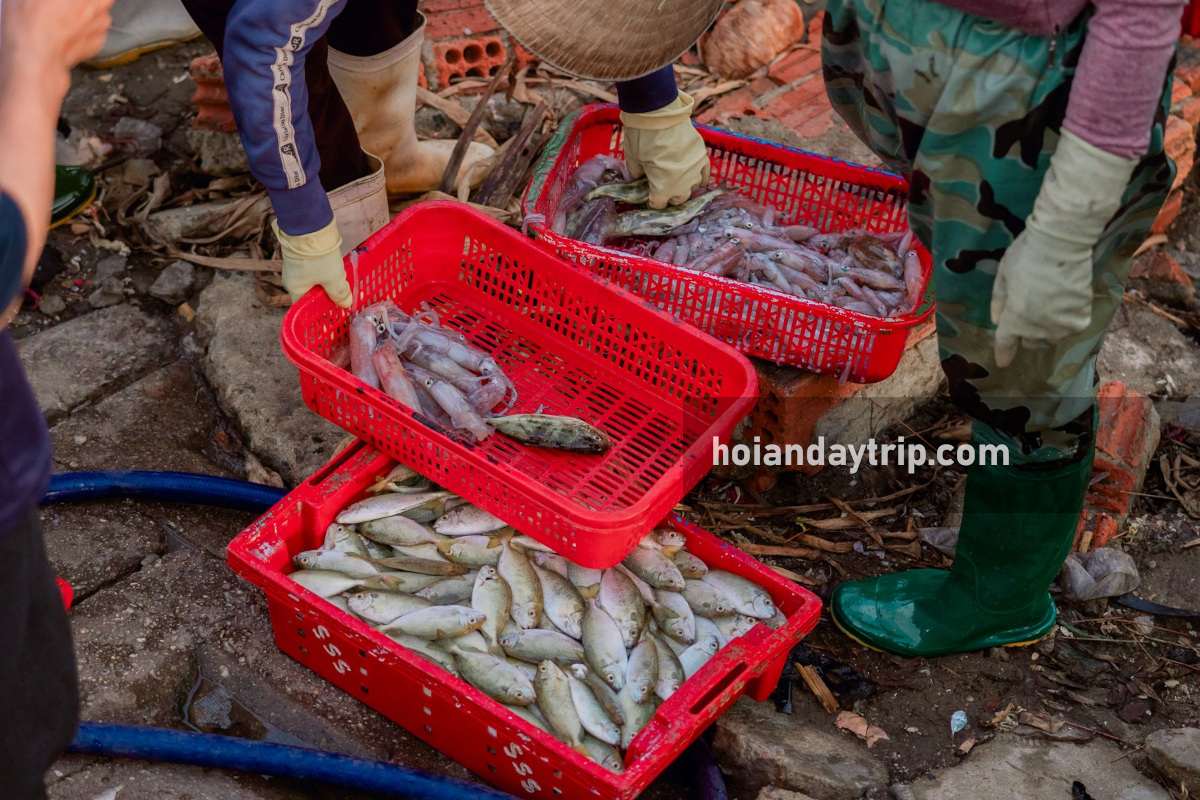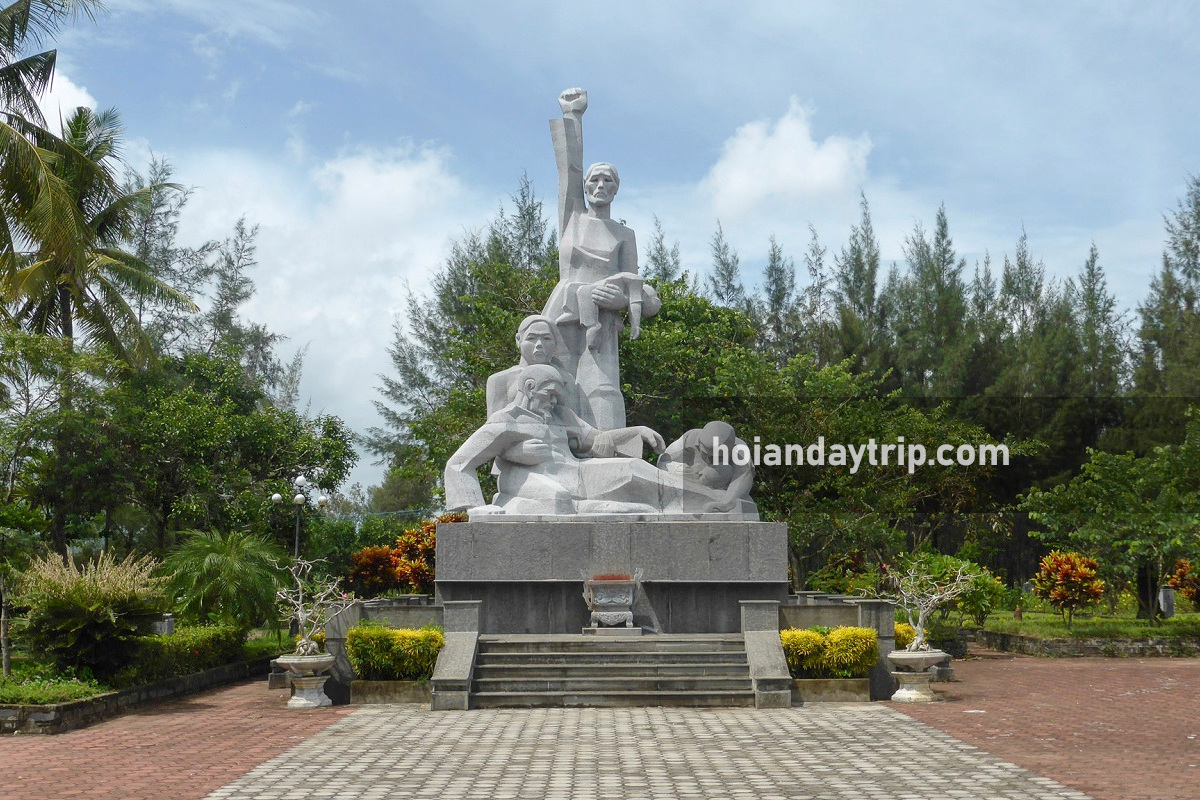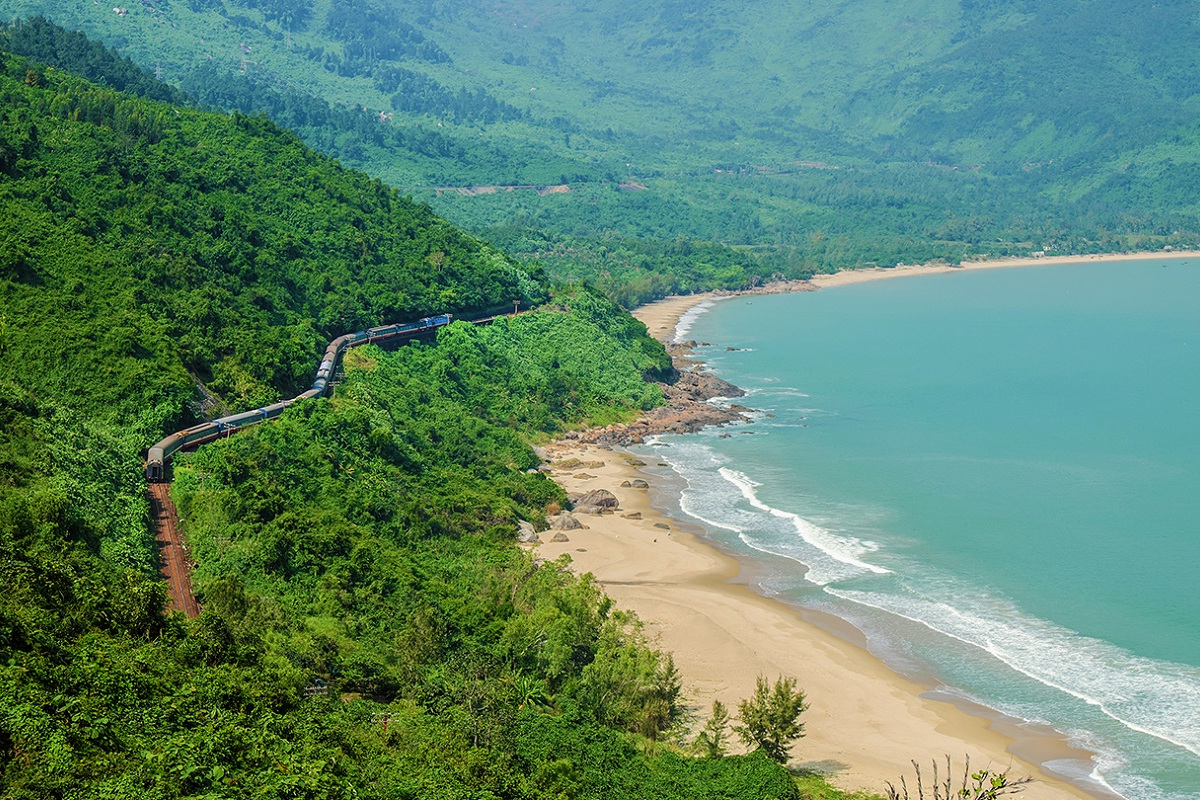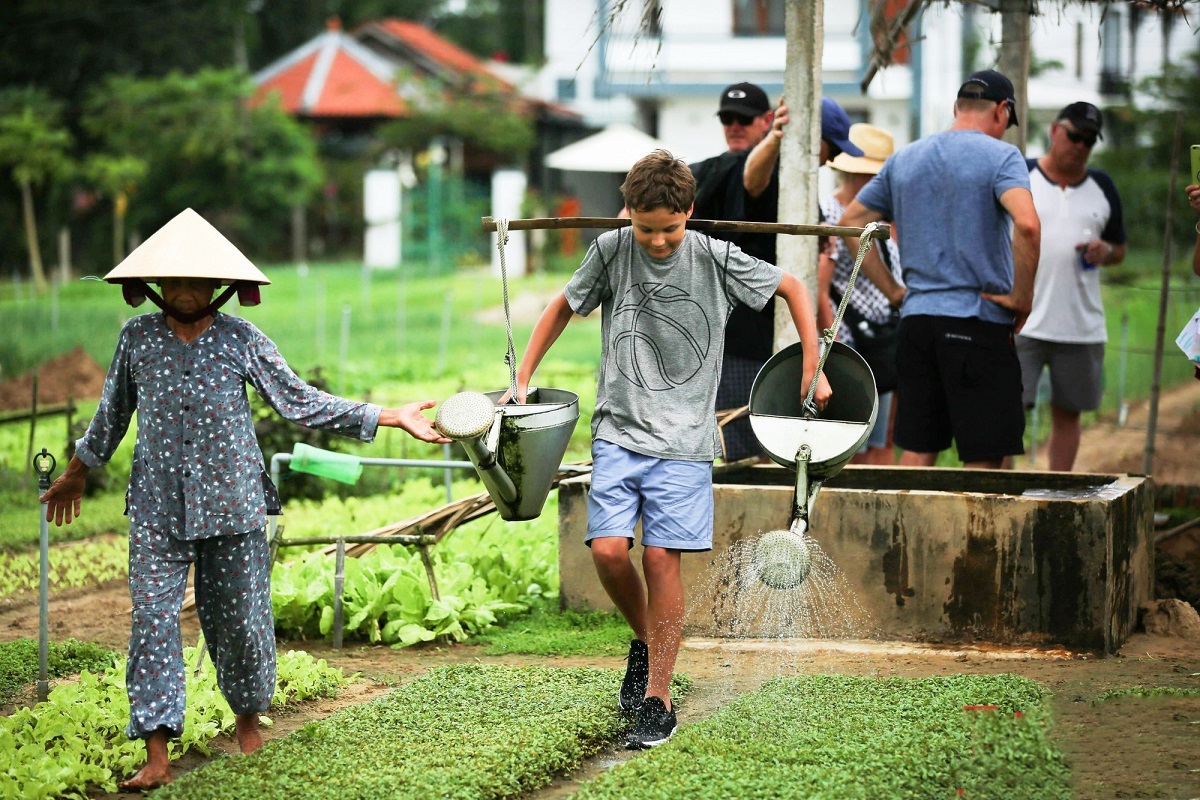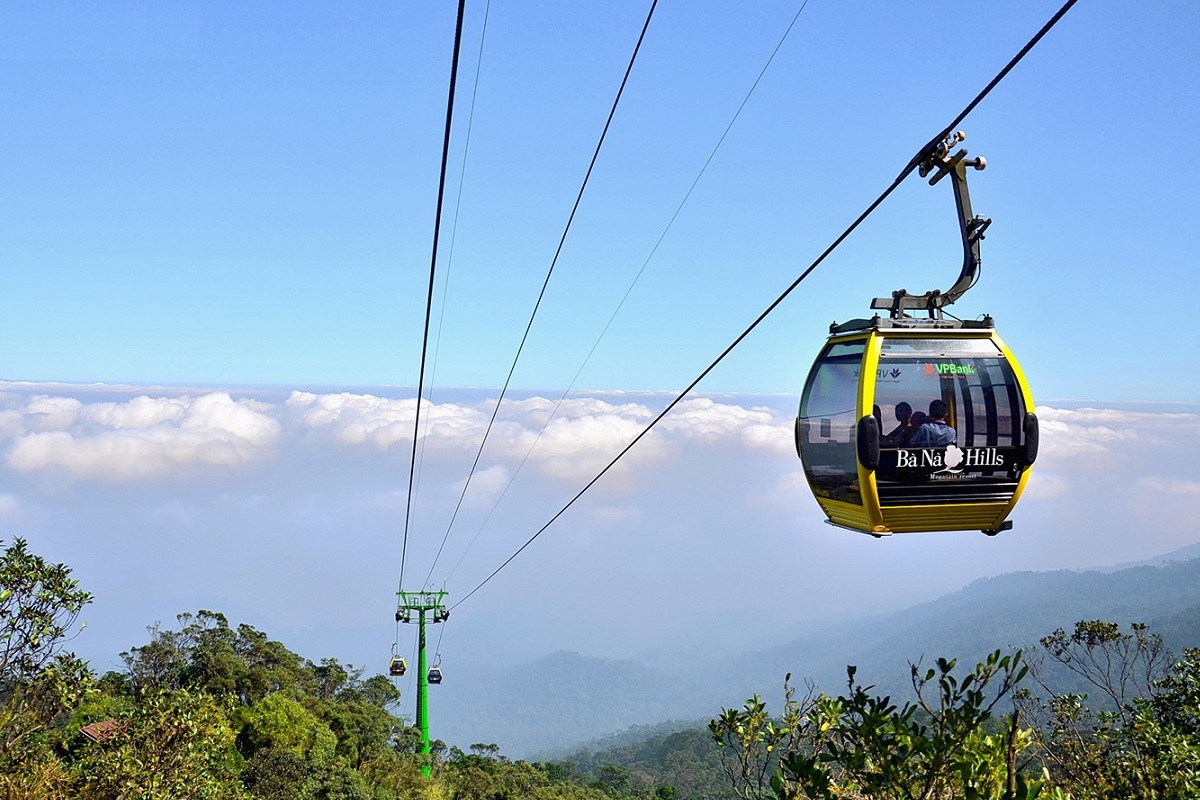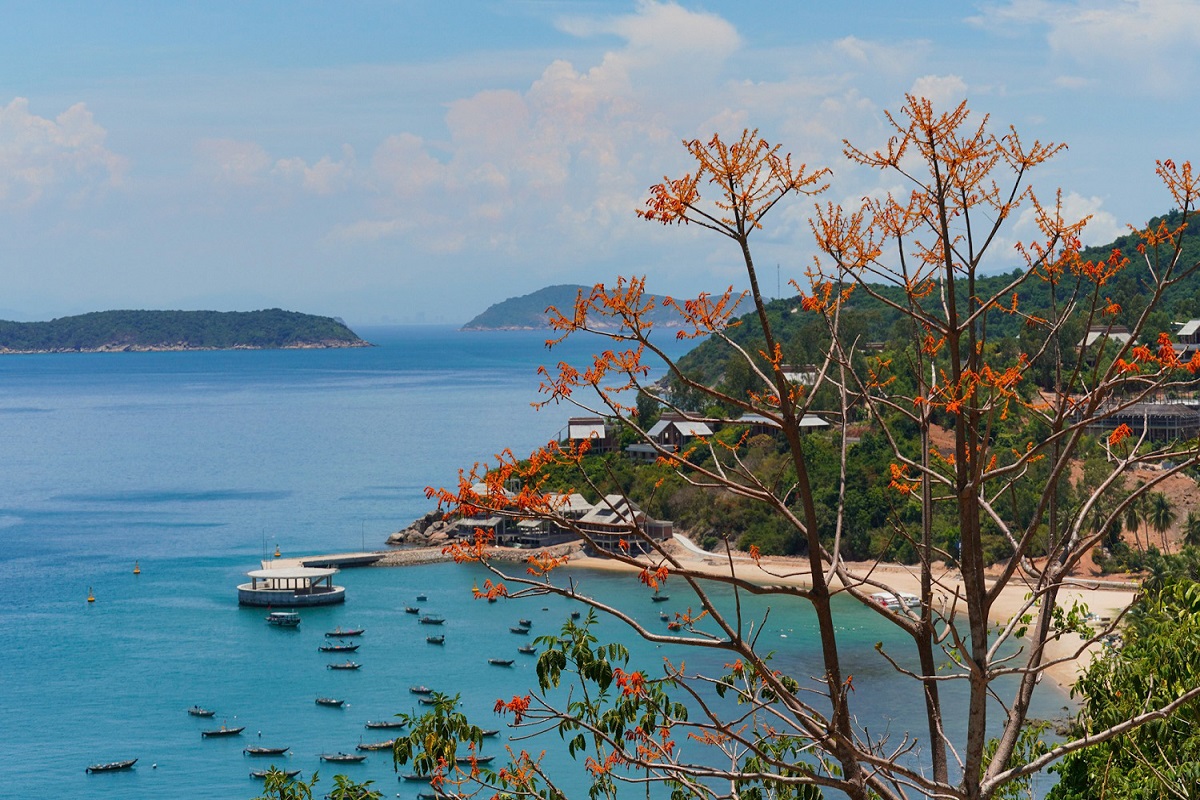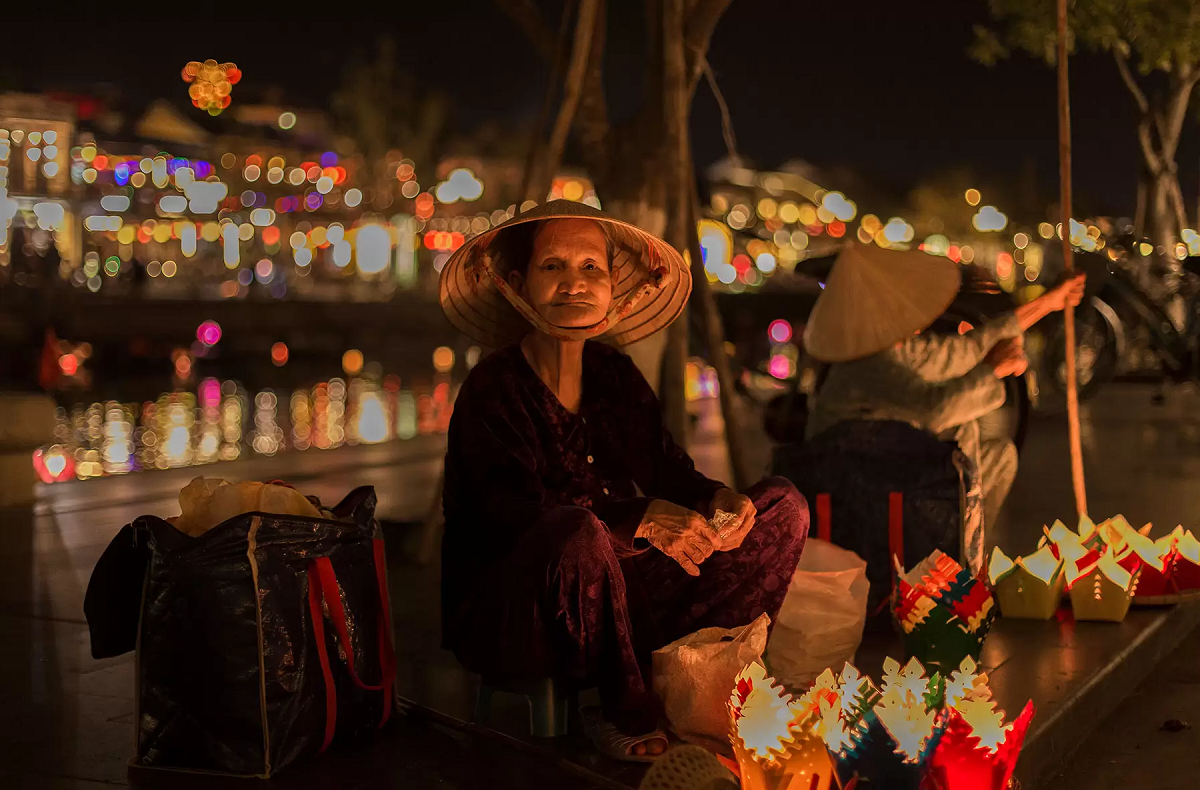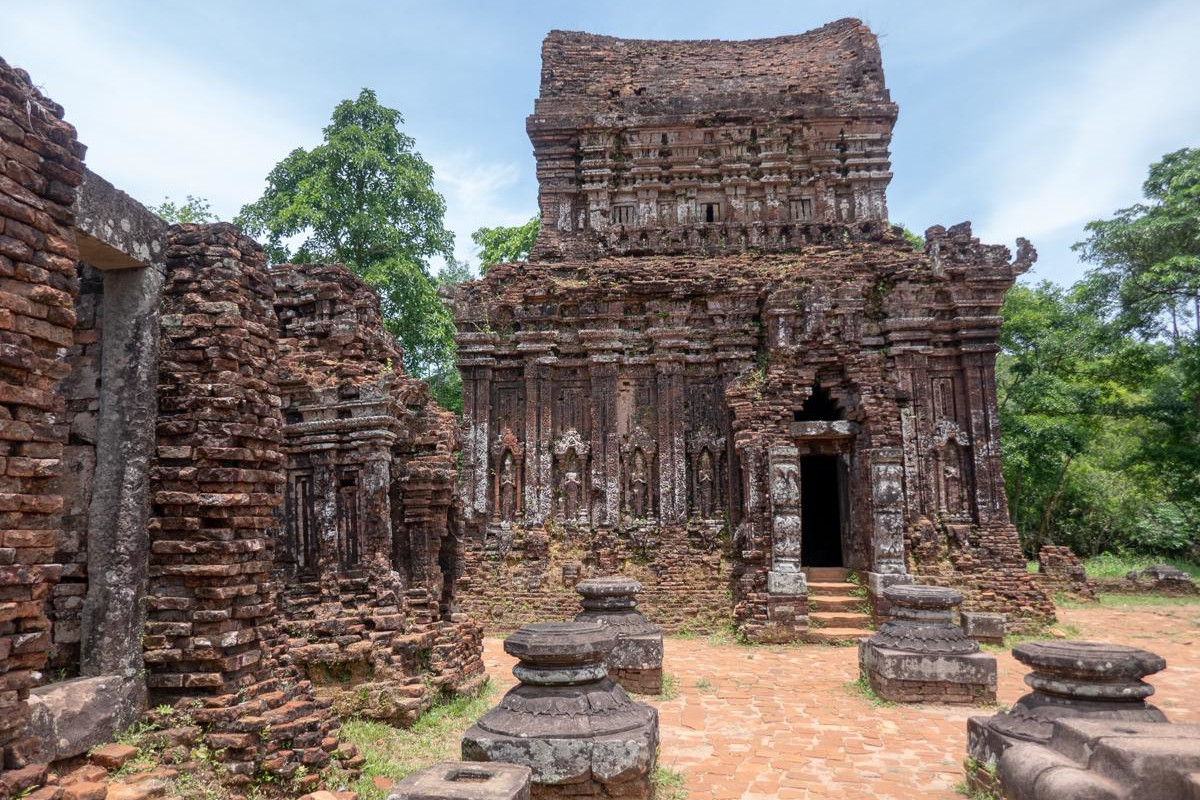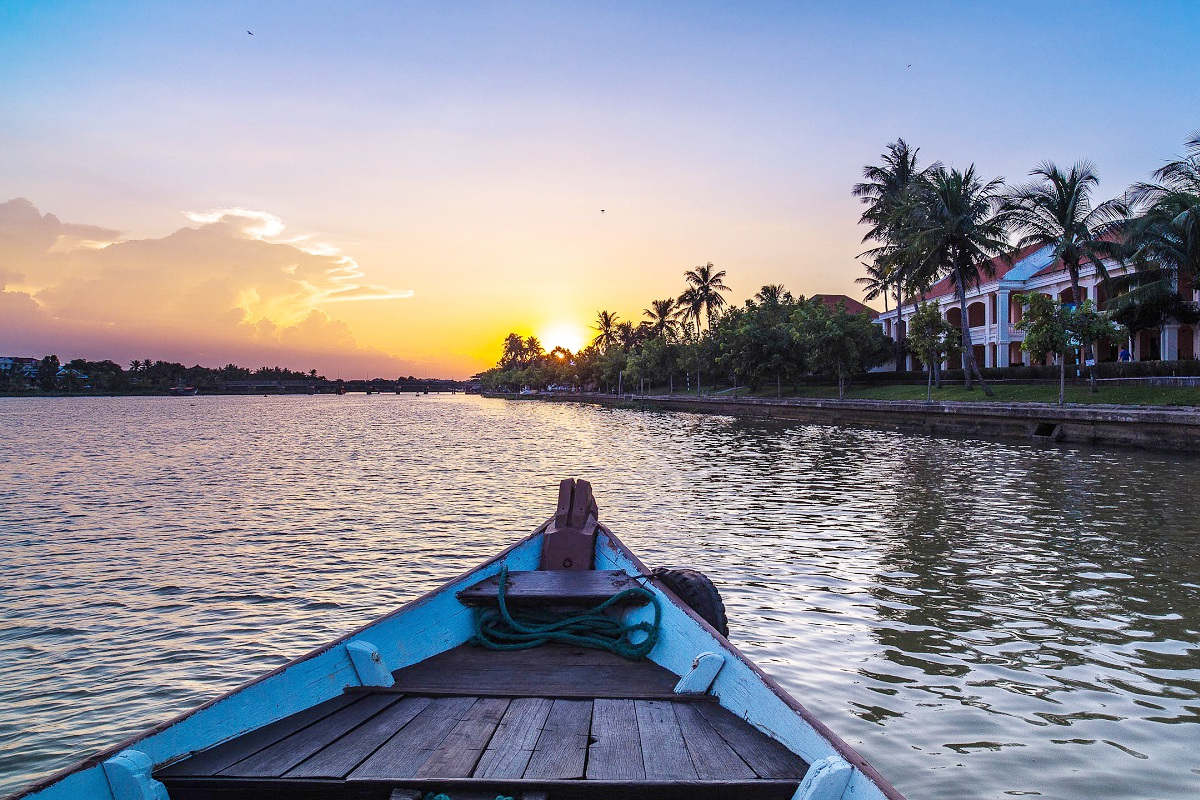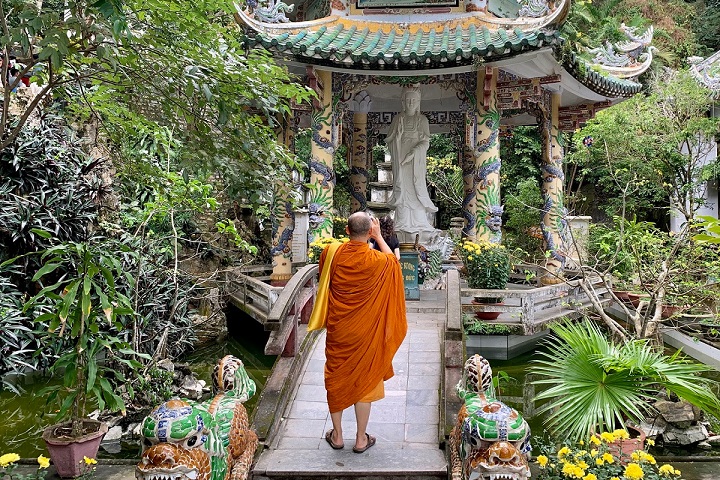Had been an offshore group of islands, geological activities shifted the Marble Mountains to the land some thousands of years before. Today, its marble hills rise suddenly up to over 100 meters from the surrounding delta. All are impressive and how they are formed still stimulates curiosity of people. It’s complicated to explain by science theories, but locals living around their foots have a legend, to make things easier to understand. Definitely the guide will share in tours to the Marble Mountains. Followed by, ancient Buddhist temples and magnificent caves await to unlock their secrets as well. This Da Nang’s best cultural attraction requires a trek if visitors want to see its main sights, including hundreds of steps.
Individually, every mountain of the Marble Mountains has its own characteristics and is named according to an element in the Five Elements theory. The largest mountain represents “water” (Thuy Son) and in its south, southwest and west, there are the Wood mountain (Moc Son), Metal mountain (Kim Son), Fire mountain (Hoa Son) and Earth mountain (Tho Son). Besides the location, the color of the rock in each hill also matches the emblematic color of the element it represents. What a coincidence! In this article, we outline an ultimate guide to the Marble Mountains in Da Nang, to help trippers find fast information they want to know and need to know about.
See also:

Table of content
- 1 What is the Marble Mountains?
- 2 The Marble Mountain Entrance Fee and Tickets
- 3 Best Time to Visit the Marble Mountains Vietnam
- 4 Dress code in the Marble Mountains: What Should I Wear?
- 5 Dress Code in the Marble Mountains
- 6 Best Time to Visit the Marble Mountains Vietnam
- 7 History of the Marble Mountains Vietnam
- 8 How to Get to the Marble Mountains and Parking
- 9 Getting around the Marble Mountains
- 10 Things to See and Do in Da Nang’s Marble Mountains
- 11 Non Nuoc Marble Village (aka Non Nuoc Stone Carving Village)
- 12 Recommended Marble Mountains Hiking Trail [MUST-READ]
- 13 Restaurants in the Marble Mountains
- 14 Festivals in the Marble Mountains
- 15 The Marble Mountains on Google Maps
- 16 Related Posts
- 17 Non Nuoc Beach: The Famous Beach of Da Nang
- 18 How to Get from Da Nang to My Son Sanctuary
- 19 Bach Ma National Park: Hiking, Trekking in Da Nang and Hoi An
- 20 Am Phu Cave (Hell Cave) – Things to Do in Da Nang
- 21 Asia Park and Sun Wheel in Da Nang (Sun World Da Nang Wonders)
- 22 How to Get to Golden Bridge from Da Nang
- 23 Da Nang Food Specialties: What to Eat in Da Nang
- 24 How to Visit Golden Bridge Vietnam
- 25 Da Nang Shore Excursions: Guided Tours From Tien Sa Port
- 26 Han Market (Cho Han): Where to Shop in Da Nang?
- 27 Da Nang Cathedral (Da Nang Pink Church)
- 28 Things to Do in Ba Na Hills Besides Golden Bridge
- 29 Da Nang Half Day Tours
- 30 Da Nang Private Car and Driver
- 31 Da Nang and Hoi An Itinerary for Visitors Staying Overnight in Hoi An
- 32 Da Nang Things to Do: Guide to What to Do in Da Nang Vietnam
- 33 Da Nang Best Things to Do and Reasons
- 34 How to Get From Hoi An to Da Nang
- 35 Hoi An or Da Nang: Which is Better for First Time Visitor?
- 36 My Son Sanctuary Tour
- 37 Da Nang Best Area to Stay: Guide to Where to Stay in Da Nang
- 38 Da Nang Cave Tour: Best Underground Activities in Da Nang
- 39 Da Nang Best Time to Visit: Guide to Best Weather in Da Nang
- 40 Da Nang Weather by Month: Guide to Monthly Weather in Da Nang
- 41 What to Do in Da Nang At Night
- 42 Lang Co Vietnam Travel Guide
- 43 What to Do in Da Nang for 3 Days
- 44 My Khe Beach: A Complete Guide to Da Nang’s Best Beach
- 45 Da Nang Day Trips: Guide to Best Day Tours From Da Nang
- 46 Museums in Da Nang
- 47 Linh Ung Pagoda: Trio of Da Nang’s Holiest Mountain Temples
- 48 Da Nang Night Market: A Thing To Do in Da Nang at Night
- 49 Guide to Son Tra Mountain (Monkey Mountain) in Da Nang, Vietnam
- 50 Ba Na Hills Tour
- 51 Da Nang Cable Car
- 52 How to Get from Da Nang Airport to Hoi An
- 53 Da Nang to Hoi An: Best Da Nang Airport Transfer and More
- 54 Hai Van Pass Da Nang: Map, Route, Weather, History, Tour
- 55 Da Nang Attractions Guide: What to See in Da Nang Vietnam?
- 56 Guide to Lady Buddha (Goddess of Mercy) in Monkey Mountain, Da Nang
- 57 My Son Sanctuary Travel Guide
- 58 Da Nang Museum of Cham Sculpture
- 59 Dragon Bridge Da Nang: The Fire-Breathing Da Nang Bridge
- 60 Ba Na Hills Travel Guide: A First Timer’s Complete Guide
- 61 Golden Bridge Da Nang: A Guide to The Iconic Da Nang Bridge
- 62 Da Nang Bridge: A Guide to Famous Bridges in Da Nang
- 63 Ba Na Hills Cable Car: World Record, Cost, Reschedule, Map
- 64 Da Nang Mountain Temple: Marble Mountain’s Pagodas, More
- 65 Da Nang Caves: Underground World of the Marble Mountains
- 66 The Marble Mountains: Guide to Da Nang’s Iconic Mountain
- 67 Featured Tours and Experiences
- 67.0.1 Bach Ma National Park Tour from Hue
- 67.0.2 Bach Ma National Park Tour from Da Nang/Hoi An
- 67.0.3 Hoi An Sunrise Fish Market Tour
- 67.0.4 My Lai Massacre Tour
- 67.0.5 Golden Bridge/Ba Na Hills & Hoi An Tour
- 67.0.6 Hoi An Instagram Tour
- 67.0.7 Ky Anh Tunnel & Tam Thanh Mural Village Tour
- 67.0.8 Da Nang to Hue Motorbike Tour with Hai Van Pass & Easy Rider (1 Way)
- 67.0.9 Hue to Da Nang Motorbike Tour with Hai Van Pass & Easy Ride (1 Way)
- 67.0.10 Hue to Hoi An Motorbike Tour with Hai Van Pass & Easy Rider (1 Way)
- 67.0.11 Hoi An to Hue Motorbike Tour with Hai Van Pass & Easy Rider (1 Way)
- 67.0.12 Tra Que Vegetable Village Tour with Cooking Class
- 67.0.13 Ba Na Hills Half Day Tour from Hoi An
- 67.0.14 Marble Mountain & Hoi An Day Tour from Da Nang Port
- 67.0.15 Hue Day Tour from Chan May Port with Lunch
- 67.0.16 Marble Mountain & Hoi An Tour from Chan May Port
- 67.0.17 Ba Na Hills/Golden Bridge Tour from Da Nang Port
- 67.0.18 Ba Na Hills/Golden Bridge Tour from Chan May Port
- 67.0.19 Golden Bridge Private Tour with Ba Na Hills & Lunch
- 67.0.20 Ba Na Hills Afternoon Tour with Golden Hands Bridge
- 67.0.21 Ba Na Hills Private Tour with Golden Hands Bridge
- 67.0.22 Ba Na Hills Half Day Tour with Golden Bridge
- 67.0.23 Ba Na Hills Early Morning Tour to Beat the Crowds
- 67.0.24 Golden Bridge and Ba Na Hills Night Tour
- 67.0.25 Golden Hands Bridge Tour In Sunrise or Sunset (1/2 Day)
- 67.0.26 Cam Kim Island Bicycle Tour From Hoi An
- 67.0.27 Cham Island Tour From Hoi An (Group Tour)
- 67.0.28 Cham Island Tour From Da Nang (Group Tour)
- 67.0.29 Hoi An Vegetarian Food Tour
- 67.0.30 Hoi An Evening Walking Food Tour with Local Foodie
- 67.0.31 Private Hoi An Basket Boat Tour (Shuttle Bus, Bicycle, Bike)
- 67.0.32 Half-day Am Phu Cave Tour (Private)
- 67.0.33 Hoi An Countryside Tour by Electric Car or Bike
- 67.0.34 Da Nang Tour Package From Singapore
- 67.0.35 Hoi An Evening Tour From Da Nang with Lantern Boat Ride
- 67.0.36 Hoi An Walking Food Tour Through Laneways
- 67.0.37 My Son Sanctuary and Hoi An Old Town Tour
- 67.0.38 My Son Day Trip From Hoi An including Marble Mountains and Basket Boat
- 67.0.39 Half Day Hoi An City Tour With River Cruise
- 67.0.40 Son Tra Peninsula Tour with Marble Mountains (Private/Small Group)
- 67.0.41 Hue Day Trip From Hoi An with Hai Van Pass, River Cruise & Lunch
- 67.0.42 Hoi An Ancient Town and Countryside Tour (Bests of Hoi An Tour)
- 67.0.43 Hoi An Tour From Da Nang Airport (Private, Optional Lunch)
- 67.0.44 Hoi An Day Trip From Da Nang (Marble Mountains, Basket Boat, Old Town)
- 67.0.45 Da Nang City Tour From Airport (Private, Optional Lunch)
- 67.0.46 Hoi An City Tour with Lantern Class, Lantern Boat, Night Market & Local Food Sampling
- 67.0.47 Marble Mountains, Basket Boat Ride & Hoi An Old Town Walking Tour
- 67.0.48 Marble Mountains & Golden Bridge/Ba Na Hills Day Tour
- 67.0.49 Marble Mountains & Monkey Mountain Tour (Half-day, Private)
- 67.0.50 Private Golden Bridge Sunrise Tour (Half-day, Optional Lunch)
What is the Marble Mountains?
A Brief Introduction
20 minutes drive from downtown, the Marble Mountains have been one of the best things to see in Da Nang since the wars ended in the city. It consists of five craggy marble towers soaring emerging on the neighboring flat plain. People believe that the hills are formed by pieces of a broken dragon egg. Thanks to being unique, this place is selected to appear in the official city logo, together with Han river and the first bridge crossing over it. Individually, from size, shape, geology, history to tourist interests, hills of it are unlike each other. The largest, highest and most-visited is Thuy Son aside Huyen Tran Cong Chua St. The mountain boasts of sacred pagodas, caves, old trees and viewpoints. It’s needed to trek around (over many steps) and 1,5 hours is the average duration to complete without rush. At the peak year, 2 million visitors come here to sightsee.
See also: Half-day Marble Mountains Tour

Marble Mountains Opening Hours
Thuy Son, the major tourist attraction in the Marble mountains, opens from 7 a.m to 5:30 p.m everyday, twelve months a year. This time doesn’t change even on the weekend, national holidays, or seasons in the year. However, travelers absolutely can visit earlier or later, to see sunrise or sunset and don’t need to pay an entrance fee. The elevator is not operated yet at that time, so if you prefer to get it, come during official opening hours. In the mountainfoot, the 2nd largest grotto Am Phu Cave opening time is same.

Names of the Marble Mountains
The Marble Mountains has different names throughout its history, the first one is Non Nuoc. The words mean “the mountain and water” because of its location near the river. Someone says this is a shorter form of “Non Nuoc Huu Tinh” , the phrase used to describe a beautiful landscape. Local people still use it to call their village and sculpture making craft. As a Buddhist sanctuary, the cluster of mountains is tagged by some other names, all related to Buddha. There are Nui Chua or “Temple mountain”, Nui Phat or “Buddha mountain”, Ngu Chi Son or “Five Buddha Fingers mountain”.
In 1837, Minh Mang king renamed the Marble Mountains in his third visit to it, from Non Nuoc to Ngu Hanh Son or “Five-elements Mountain”. Main reason to explain this is that this emperor realizes a magic coincidence between location and characteristics of its hills and principles in the Five element theory. Since then, Ngu Hanh Son became the official name of the entire complex, and the district it’s located in 1997. Additionally, each mountain in the complex also has its own title, taken from five elements as water (Thuy), fire (Hoa), wood (Moc), metal (Kim) and earth (Tho). The king requested to carve the names on the rock of their owners then.
In colonial times, French called what international tourists call nowadays, the Marble Mountains, basing on its geology. During the Vietnam war, the Americans kept using it and used to name their marine base nearby.

The Marble Mountain Entrance Fee and Tickets
News: Da Nang people committee decided not to charge the Marble Mountains entrance fee in the entire year of 2022. Three other museums made the same decision, including the Cham sculpture, the Fine art and Da Nang museum.
The Marble Mountains entrance fee is 40.000 VND for adults and travelers above 6-years-old. For childrens under 6-years-old and kids, it’s free. Again, this entry fee is for sightseeing Thuy Son, the main attraction and sights around its top. Ticket to visit Am Phu Cave in its foot is separate, 20,000 VND for adults and persons older than 6 and free to the younger ones. Location of this place is near the elevator and car parkings. The rest of the Marble Mountains is without an admission.
The Marble Mountains elevator ticket is another thing travelers need to know also. The lift aims to help visitors who would like to skip 132 steps to Linh Ung temple. This service is very helpful to elders, kids and disabilities. Its price is 15.000 VND one way, for adults and persons above 6-years-old and free of charge to smaller ages. To buy, the ticket counter stands near the elevator, gate 2 and some sculpture stores. It’s possible to purchase the ticket down there also. In high season, queues may occur but not too long. Up the mountain, ask how to get to Xa Loi tower to see the counter and elevator itself if you don’t buy (or lose) the ticket on the mountain foot. Many tourists choose to walk downstairs to finish the trail, to see more.
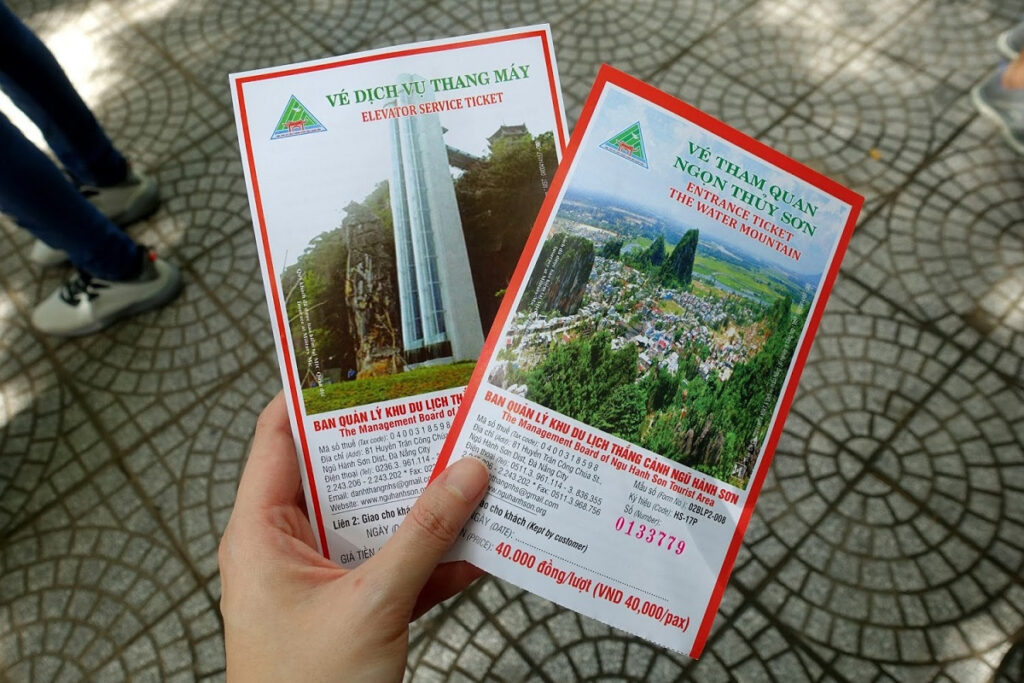

Best Time to Visit the Marble Mountains Vietnam
Travelers can expect sunny days to sightsee the Marble Mountains during the dry season, from January to July yearly. The period features an average temperature of about 25,7oC, low rainfall and free from typhoons. Sightseers should wear lightweight clothings and put sun cream, sun glasses and lots of water in their bag before leaving the hotel. To avoid strong heat (and tourist crowds), should also visit in the morning or after mid-afternoon. Plenty of people pick the times to watch sunrise and sunset from high elevations over lower plains. If trek around the mountain in the midday, will be quickly sweaty and tired, especially elders and childrens. The evening is cool, peaceful to walk around and ticket-free but the scenic landscapes are lost. Between May and August, the temperature reaches its peak, sometimes up to nearly 40OC. Check the weather forecast in advance.
From the end of August to December, temperature is lower and rains increasingly occur. Yes, these weather features make sightseers feel more comfortable to trek around, but the steps along it are slippery usually. In the cave, the floor is always wet, causing falls anytime. Be careful of that and watch out for your footsteps when you come to the Marble Mountains in the wet season. Sometimes, typhoons hit the area and the complex is closed. Remember to check news updates in official social media and check weather forecasts, to avoid wasting time and money. Rain coat, umbrella and waterproof shoes are a must have. If you don’t have one, you can buy them in local stores around mountain foot.
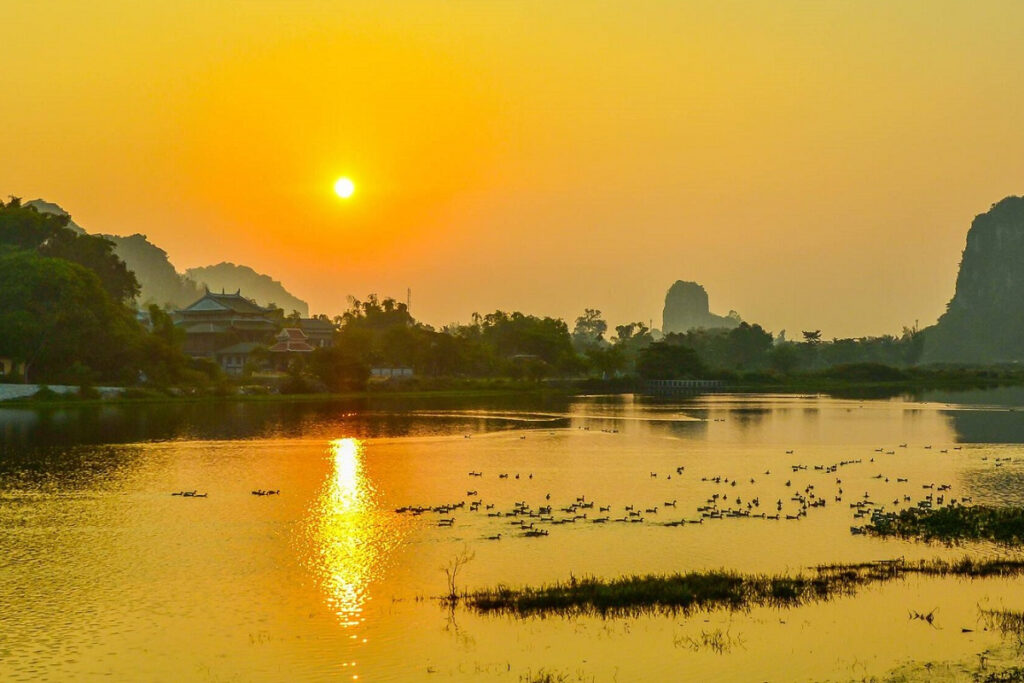
Dress code in the Marble Mountains: What Should I Wear?
Vietnamese wear respectively when visiting the Marble mountains, because it’s a Buddhist site. Particularly, they get on clothings that covers their navel, armpits and knees. Because of having to trek up hundreds of steps, sightseers may wear different clothing. Shorter and lighter items are preferences to make them feel pleasant in the high temperature. The dress code is not strictly checked in the attraction and chiefly depends on visitor awareness. So, walking around is okay but if you like to come inside temples, covering is a must do. The monks prepare several sarongs for free near the door of the main shrine. Just take one if you have no ideas about before arriving at the Marble mountains.
A pair of good shoes is the next necessary thing. Should choose the ones that are proper to climb up the Marble mountains. At least 1.000 steps needed to finish if travelers like to visit every highlight and in many times, jagged rocks replace the step. During the rainy season, be careful (especially your little ones) and watch out for footsteps. Have waterproof footwear? Select that to prevent the feet from being wet. The rains also make the floor of caves slippery. Sun cream, sun glasses, insect repellent and some bottles of water should be put in the bag prior to heads over this famed sight.
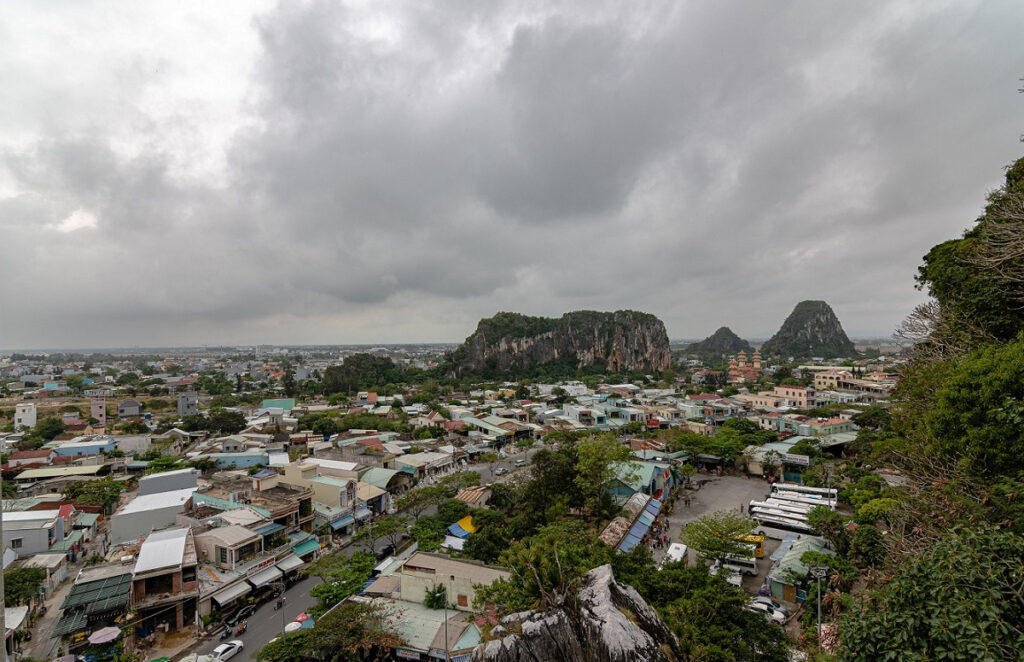
Dress Code in the Marble Mountains
Vietnamese wear respectively when visiting the Marble mountains, because it’s a Buddhist site. Particularly, they get on clothings that covers their navel, armpits and knees. Because of having to trek up hundreds of steps, sightseers may wear different clothing. Shorter and lighter items are preferences to make them feel pleasant in the high temperature. The dress code is not strictly checked in the attraction and chiefly depends on visitor awareness. So, walking around is okay but if you like to come inside temples, covering is a must do. The monks prepare several sarongs for free near the door of the main shrine. Just take one if you have no ideas about before arriving at the Marble mountains.
A pair of good shoes is the next necessary thing. Should choose the ones that are proper to climb up the Marble mountains. At least 1.000 steps needed to finish if travelers like to visit every highlight and in many times, jagged rocks replace the step. During the rainy season, be careful (especially your little ones) and watch out for footsteps. Have waterproof footwear? Select that to prevent the feet from being wet. The rains also make the floor of caves slippery. Sun cream, sun glasses, insect repellent and some bottles of water should be put in the bag prior to heads over this famed sight.

Best Time to Visit the Marble Mountains Vietnam
Travelers can expect sunny days to sightsee the Marble Mountains during the dry season, from January to July yearly. The period features an average temperature of about 25,7oC, low rainfall and free from typhoons. Sightseers should wear lightweight clothings and put sun cream, sun glasses and lots of water in their bag before leaving the hotel. To avoid strong heat (and tourist crowds), should also visit in the morning or after mid-afternoon. Plenty of people pick the times to watch sunrise and sunset from high elevations over lower plains. If trek around the mountain in the midday, will be quickly sweaty and tired, especially elders and childrens. The evening is cool, peaceful to walk around and ticket-free but the scenic landscapes are lost. Between May and August, the temperature reaches its peak, sometimes up to nearly 40OC. Check the weather forecast in advance.
From the end of August to December, temperature is lower and rains increasingly occur. Yes, these weather features make sightseers feel more comfortable to trek around, but the steps along it are slippery usually. In the cave, the floor is always wet, causing falls anytime. Be careful of that and watch out for your footsteps when you come to the Marble Mountains in the wet season. Sometimes, typhoons hit the area and the complex is closed. Remember to check news updates in official social media and check weather forecasts, to avoid wasting time and money. Rain coat, umbrella and waterproof shoes are a must have. If you don’t have one, you can buy them in local stores around mountain foot.

History of the Marble Mountains Vietnam
Tale about Formation of the Marble Mountains
Geologists say that the Marble Mountains were formed by complicated geological activities. But for locals, they have an easier way to explain why the hills come to the Earth. According to their tale, mountains are pieces of a broken egg which is laid by the Sacred Dragon, the King of the Sea. After giving birth, an old man is responsible for keeping safety for the blood of the dragon. To better know his call for help whenever he needs, the Turtle God gives him a nail.
Day to day, unbelievably the egg is bigger and bigger and can’t hide in the small cottage of the old man anymore. One day, a group of bad people come to the egg to rob because they never ever see a giant thing like that. The man quickly asks for an assist from the Turtle God. After a blinding beam of light, the robbers and the egg disappear. Only a beautiful young girl is visible before the man’s eyes. She is the dragon daughter and has lived with her adoptive father since then.
The small family guides people how to plant rice, catch seafoods or weave for living. Someday, a prince falls in love with her at first sight and proposes for a marriage then. When she becomes a queen, the old man is invited to live with the Turtle God under the sea. Therefore, five marble mountains have existed and inspired countless people.
Hindu Sanctuary of Champa Kingdom
Historians believe that the Marble Mountains was a Hindu sanctuary of the Champa kingdom for centuries, before Vietnamese people arrived. Remains in this holy place are still visible today around the hills, both on and under the ground. During French archaeologist’s visits in the 19th and 20th centuries, they saw and discovered many intricate sculptures and masterpieces. Much of which were brought to their home country after. In traveler trekking today, it’s possible to see Cham works of art in Linh Ung pagoda and its behind cave, Huyen Khong cave (near the guardian staircase). If you would like to see more, come to the Cham sculpture in the city center or My Son sanctuary, 70km to the south.
Vietnamese Regional Buddhist Center
When they settled the land, Vietnamese established many Buddhist temples in the Marble mountains to pray and continue the former religious role of the complex. However, in early stages, the pagodas are made of wood and thatch, and monks live in the caves. In later times, thanks to better finance, locals donate money to build the edifices by durable materials. Especially, Minh Mang king (of the Nguyen dynasty) requested to enlarge 2 temples in 19th century. He also gave many artifacts and titled them as the national pagodas.
In the 17th century, famous Chinese monk Thich Dai San visited the Marble mountains before going to Hue to see Nguyen Phuc Chu lord, the inviter. Back home, he left his feelings and thoughts in his diary about this scenic place (although don’t mean to stay over there at first). According to him, the cluster of hills is equally beautiful as the well-known mountains in his home country China. In Hue, this monk went to see Thien Mu pagoda too.
Not only the largest Thuy Son, Kim Son mountain also houses old and large pagodas. It is the host of the annual Quan The Am festival, the biggest Buddhist celebration in the city. The one aims to honor the Lady Buddha and pray for beautiful and positive things in life. Formerly, king’s boats often arrive here before reaching the others, as it stands by the river. The neighboring Fire and Earth mountains are the background of numerous pagodas built around their foots.
Three Visits of Minh Mang King
Minh Mang might be the emperor of most visits to the Marble mountains in history. During his 20-years reign, he spent time in the attraction thrice. His first visit ever was in 1825. At that time, he built the steps leading to major pagodas, constructed and titled them as the national temples. Two years later, this emperor sent 9 Buddha statues and 3 large bells to the monks in the second visit. The last time was in 1837, when the whole complex and all of its individuals were renamed according to the Five elements theory. Two high stations were also added to view the river (called the Giang Vong Dai) and the sea (called Hai Vong Dai). For historians, these are also used for military and weather observations.
Marble Mountain during Vietnam War
To make full use of a network of interconnected caves, Vietnamese communists (shortly Vietcong) hid in the Marble mountains during the Vietnam war. Not only lived and met, they also established a field hospital in Am Phu cave (Thuy Son), to cure sick veterans, injured soldiers and locals. Information about this important facility is always strictly-kept. Buddhist monks supported food and security the strugglers.
Here, one of the most heroic Da Nang-borned communists, Phan Hiep, becomes a part of history. He led a battalion in the Tet offensive 1968, to attack on an American military base close by. His team eliminated some hundreds of soldiers of the enemy by rudimentary guns, destroyed 38 airplanes and at least 100 jeep cars. After the battle, he was renamed to Phan Hanh Son, two final words that are the same as the Marble mountains in Vietnamese (Ngu Hanh Son). Meanwhile, the title “national hero” was awarded to him. The scene of how he and his friends were brave is depicted and engraved on the wall of the cave today. After the fall of Saigon-based government in 1975, he moved to the capital for work for the Vietnam people’s army. In 1979, continued to be in the war in Cambodia, to protect innocent people from the Khmer Rouge. Now, Hiep’s name is used for streets all over the country.
On the other side, the summits in the Marble mountains served for American air forces during the war thanks to their elevation. In its northern plain, a new airfield was constructed (the second in Da Nang), with the name “the Saltwater marine base” or more popular “Marble Mountain marine base”. This is amongst the most important military bases for American and South Vietnamese armies during its existence. Up to date, it’s role is kept and usually serves for helicopter rides for tourists. Commercial flights are not allowed to depart or land here yet.
The Marble Mountains Rock Inscriptions: The Next Unesco Heritage
After the 15th century, the Marble Mountains became a regional Buddhist center. It drew many people coming to visit and pray, including Nguyen emperors and lords, famous Buddhists, writers, poets and merchants from trading town Hoi An. Many of them hired local artists and left their literature works on the walls of the caves. Today, there are at least 90 inscriptions known by us. The earliest one is Pho Da Son Linh Trung Phat stele, engraved on the wall of Hoa Nghiem cave in 1640. Its content listed the names of Vietnamese and foreign traders in Hoi An who donated money to renovate pagodas. Its words include “Hoi An village”, the first time the name has been mentioned ever in the history. Not only formerly-used Chinese, modern Vietnamese also can be found around. Da Nang city has submitted to Unesco to inscribe this collection of inscriptions, to be a world documentary heritage.
How to Get to the Marble Mountains and Parking
Where are the Marble Mountains?
Da Nang’s Marble Mountains are 10 km southeast of the Dragon bridge in the city downtown and 12km from the airport. It stands by main boulevards leading from there to Hoi An, another famous tourist city. There are Le Van Hien road (the inner) and Truong Sa road (the coastal). For that reason, many travelers choose to visit the hills on the way to transfer. Additionally, this prime location is also convenient to get from other attractions, like the Lady Buddha, My Khe beach or Ba Na hills-Golden bridge. Sit by the river, formerly people traveled by boat and landed near the Metal mountain (Kim Son), 1km from the best Thuy Son. Now, it’s rare.
From Da Nang Center
Visitors can get to the Marble mountains by most road vehicles, thanks to the convenient location of the attraction. Motorcycles are the best choice for local people and those who love a flexible itinerary. It’s easy to hire in the hotel, or online shops with a price ranging from 100,000 to 250,000 VND. Bike parking in the site is 5,000 VND but higher if leaving it in shophouses near gates leading up the mountain. Easy and free also, taxi charges are more expensive, often smaller than 200.000 VND for four seats. If you take larger cars, the fare will be increased. To get one, ask for help in the reception for departure. In the Marble mountains, taxi riders are many to reach the next place. Private car is more proper to travel a long distance for many attractions, rather than a short drive.
Operated from 5:30 a.m to 5:30 p.m daily, Bus 1 (Da Nang Hoi An Bus) moves around the city center before drops off passengers near the Marble mountains, in Le Van Hien St. Its frequency is around 30 minutes and ticket price is 20,000 VND for adults. From the stopping point, it’s possible to walk to the counters to buy a ticket and start the trek. Time well for the visit if you do not want to miss the last bus, in late afternoon. Other vehicles like bicycles, jeep or even boats are more available in the tours.
Marble Mountains is a Popular Stop From Da Nang Airport to Hoi An
Located halfway from Da Nang airport to Hoi An, favorite city to stay over for international tourists, the Marble Mountains is usually a stop to visit. Distance between two places is 12km and so, it takes around 25 minutes to move. Moreover, each visitor should spend at least 1,5hrs in the mountains to trek around and sightsee. For that reason, should arrive before 4 p.m if liking to see its highlights when the sun is still up. The last tickets are sold at 5 p.m. In case of flying at night, explore the cluster of hills on the way to return to the airport from Hoi An.
Taxis are always available at the arrival gates, charging not more than 200,000 VND for a ride to the Marble mountains. The fare is at a higher rate if you get on larger cars. There are many drivers around the foot of the hill also, to reach the hotel in Hoi An after the trek. An additional fee may be surcharged, to pay for waiting and parking. Private car is another choice, offered with a kind of similar price. After picking up, the luggages are kept in the car until hotel check in, an advantage. Online booking is popular for this transfer because of convenience and cheaper deals. Bus 1 in Da Nang provides a stop that is within walking distance to the ticket counters, but it needs to be transferred by another vehicle to the nearest stations.
From Hoi An to Marble Mountains
Taxi and Private Car
Taxis are easy to get anywhere in Hoi An, especially around its Old town. The shortest distance to the Marble Mountains is about 17 km, so the taxi fare is approximately 250,000 VND. In the hills, the drivers always stand near the entrance gates or in Huyen Tran Cong Chua St, just approach and ask them for a ride to go to the next place. The fare for each kilometer is kind of similar to in Hoi An. If like to explore more attractions in Da Nang, should contact in advance to taxi companies to have better offers, it means cheaper rides. A driver will come to your hotel to pick up on time. He may know basic English.
Getting a private car is another method to make a comfortable ride to the Marble mountains. Ask friends who have ever traveled to Hoi An or Da Nang before, to know their recommendations. If you have ideas about, just search online or come to the reception or a tour operator near the room. Should check reviews written down by past passengers of the liked company and compare the price between reliable providers to find out the best option.
By Motorcycle
Domestic tourists and free-style travelers usually ride motorcycles to get from Hoi An to the Marble Mountains. The coastal road Lac Long Quan and the inner one DT607 are two common choices, each owning different features. The first provides a lower traffic but the distance will be longer, while the second provides the quickest reach to the hills but busier. It takes about 30 mins no matter what. If you can arrange a full day out, don’t forget to discover Hai Van pass, not far to the north or Son Tra mountain. Both places are stunning, packed with picturesque views and give fun rides. Automatic bikes are not allowed to access the last-mentioned attraction, to keep the rider safe.
By Bicycle
The Marble Mountains is 17 km from Hoi An center, so getting there with a bicycle is suitable enough for those looking for some adrenaline. The coast road Lac Long Quan St is popularly-selected because of its lower traffic than the inner one. Lots of resorts and accessways for quite sandy beaches are to its left. Ride along the Co Co river if you prefer back roads (at least laid-back traffic).
By Hoi An Da Nang Bus
Lots of travelers take the public bus to get to the Marble Mountains from Hoi An. It departs at 5:30 a.m in Hoi An’s bus station and there, the last bus leaves at 5:50 p.m. The frequency is about 30 minutes. It takes not more than an hour to reach the nearest station to the hills because there are not many stops. After getting off, just walk along Huyen Tran Cong Chua St to arrive at two gates where the tickets are sold. Gate 1 leading to Tam Thai pagoda requires the shortest distance, and if you like to get the elevator or see Linh Ung pagoda first, move further to Gate 2. Ticket price is 20,000 VND for the whole ride (to Da Nang’s central bus station). Should prepare small cash in advance to pay, because many tourists say that the attendant often gives a wrong exchange or seems to forget exchanging. To protect you, do it!
Parking Lots and Fees
If you ride your own bike, travelers can leave it in the public parking near the elevator or in shops beside Huyen Tran Cong Chua St. The fee is 5.000 VND and 10,000 VND respectively. Remember the right location and number of your bike to avoid disappointments.
Getting around the Marble Mountains
Travelers have to walk over many steps if they want to visit nearly all of the famous sights in the Marble Mountains. Number of steps may be up to some hundreds, therefore you should think carefully before making up your mind to explore, especially for small childrens and elders. An elevator is installed to allow tourists to skip 108 steps from the ground to Linh Ung pagoda (and the cave behind it). If just want to sightsee a part of the mountain, get it straight to save time and stay away from being sweaty on hot days. On the other hand, if would like to see everything, the rest of the trekking trail is necessary to complete. In the foot of Thuy Son, Am Phu Cave is for all ages and seasons. It has steps but not much.

Things to See and Do in Da Nang’s Marble Mountains
Marble Mountain Buddhist Temple
The Marble Mountains is home of various Buddhist temples that are wonderful additions into its scenic landscape. Additionally, these religious places also draw more visitors, making it become one of the most visited attractions in the region. Its temple collection includes Linh Ung pagoda, Da Nang’s oldest pagoda and one of two national-level pagodas titled by the king. The other is Tam Thai, on the other side of Thuy Son mountain.
To the southwest, Kim Son (“Metal mountain”) has Quan The Am pagoda, the host of the largest traditional festival in Da Nang and the country. When completed, the new Quan The Am pagoda there is the grandest as well. Thus, a trip to temples around the Marble Mountains gives travelers the chance to learn more about history and marvel at old-styled architecture. Except for the festivals, on the first and the 15th day of every lunar month, lots of people come to the temples to pray.
Browse our separate article for Da Nang’s mountain temples to know more about the pagodas in the Marble Mountains. Their history and architecture are informed in detail.
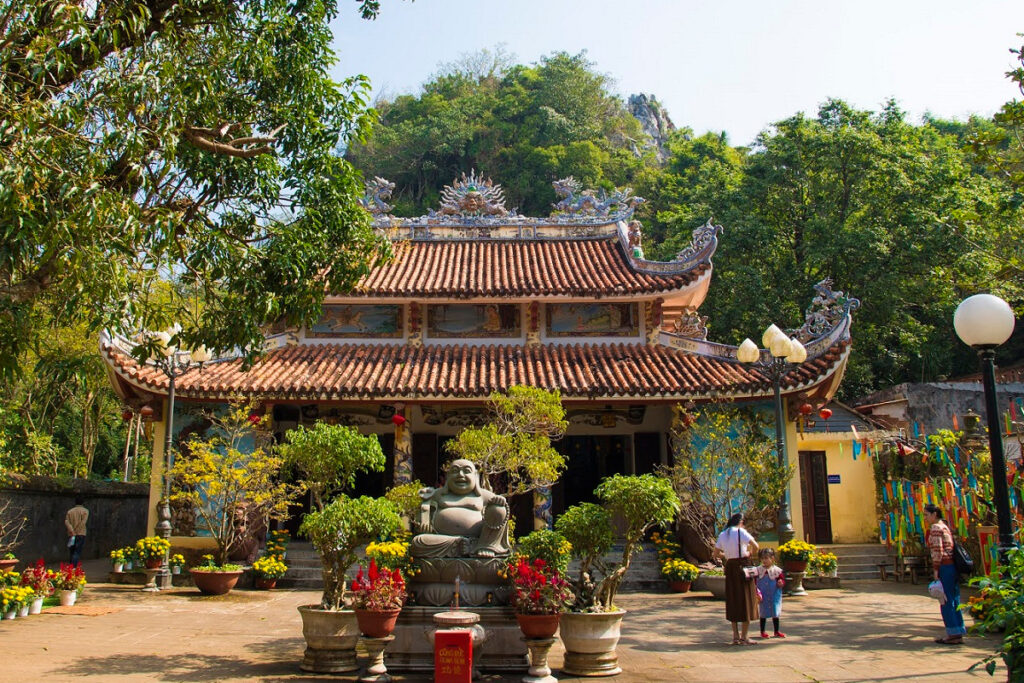
Marble Mountain Caves
If looking for a cave exploration, the Marble Mountains is one of the best choices to go to, right near Da Nang downtown. This complex owns some dozens of small to large caves, making it become the most dense cave system in the city. Almost all of them are possible to be connected to each other. In Thuy Son mountain, the largest one is Huyen Khong cave and its height is up to 30 meters from the floor. Travelers can see the breath-taking scene of lightfall here, of course on sunny days. There are some of the most sacred temples built in its main chamber.
In the same hill and the upper part, Tang Chon cave is a group of small grottoes, but each owns its own shrine. Down the steps, Am Phu cave is the second largest, drawing many tourists because of its huge size and stunning Buddhist concept about the life of people after death. Historic relation to the Vietnam war here is absolutely shared by the tour guide. Still in Thuy Son or in other mountains, visitors can discover smaller and little-known caves. In conclusion, an expedition in caves of the Marble Mountains provides the chance to see delightful creations of nature, understand better local belief at temples and awesome climbings. It’s worth a trip!
To read details about all grottoes in the Marble Mountains, read our complete travel guide to Da Nang’s caves.

Xa Loi Tower
Near the elevator, this 28-meters-tall tower is easy to see from the foot of Thuy Son. It’s built in 1997 and inaugurated in 2004. It has seven floors, symbolizing 7 first steps the Great Buddha walked after borned. Its octagonal shape represents 6 perceptions of humans in Buddhism. The name, Xa Loi, means “the Buddha relic”. According to history, was cremated after death and his ashes are divided into 84.000 portions. His followers took them to many cities in India and countries around the globe. One of them is preserved and enshrined in the highest floor of this building. Its first floor is for worship of Sakyamuni, Ananda (Buddha’s beloved disciple) and Mahakasyapa (another principal disciple). In other floors, people honor arhats who have reached the Enlightenment and full Buddhahood. In recent times, the architecture of Xa Loi tower is copied in new temples across the region.
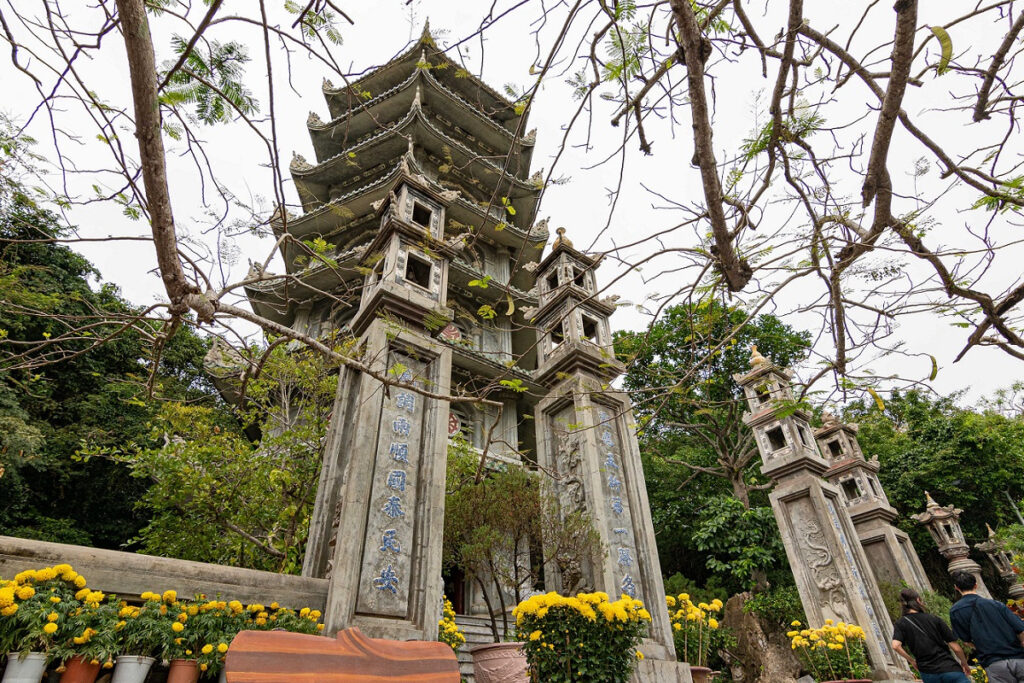
The Heaven Gate
The Heaven Gate is what locals call a summit of Thuy Son. The steps leading to it are from the gate behind Tam Thai Pagoda and they are quite steep. When climbing close by, visitors have to walk on worn-surface rocks if they like to view panoramic sceneries. The best advice is be careful and should near the handrail, to minimize slipping or injuring.
From this peak, picture-like landscape and cool winds are the gifts for climbers. The city, coast, resorts and river all can be captured. During the sunset, it’s an ideal location to enjoy and take photos. When standing on the rocks for photography, should be careful again to avoid falling down to the sharp marbles. Cacti around have painful thorns. If traveling with childrens, keep your eyes on them usually to keep their safety.

Vong Hai Dai and Vong Giang Dai Viewpoints
Besides the highest location visitors can reach, the Heaven gate, two viewpoints Vong Hai Dai and Vong Giang Dai also provide sweeping sceneries over lower plain or sea. Both are built in 1837, topped with a pavillion and stele carved with Chinese letters (their own name) in the middle. The first stands near Linh Ung pagoda and means “viewpoint to view the sea”. Generally, steps leading to this point of interest are steep, from either the pagoda or elevator. In another side of the mountain, the second means “viewpoint to view the river” and by that, it’s possible to take pictures with river as well as other outcrops. Lots of people love to come there in the afternoon to see sunset and unwind. Steps are not much but steep, slippery especially at white worn marbles. Remember to walk carefully or climb along the handrail to keep yourself away from injuries.
Rock Climbing
The Marble Mountains accommodates a lot of rock faces which allow travelers to enjoy the climbing with their rope. The activity is available daily in some local adventure companies. The tour of course includes a regular visit around the mountain and learning about history.
Da Nang Museum of Buddhist Culture
Within the on-going Quan The Am pagoda in Kim Son mountain, this is the first Buddhist culture museum in the country. When you arrive, ask people there to know the right direction to get there. Opened from 2014, it exhibits nearly 500 old artifacts collected in Vietnam and some countries around the world. 10 amongst them are evaluated equally to a national treasure, based on their values. So, a visit here provides the great chance to know better Buddhist art of the region and admire the talent of former artists. No ticket required.
Non Nuoc Marble Village (aka Non Nuoc Stone Carving Village)
History of Non Nuoc Marble Village
Inhabitants around the Marble Mountains are proud of their traditional craft in carving sculptures which has been preserved as a national intangible heritage. This tradition started from the 17th century and sir Huynh Ba Quat is seen as the first artisan. He was borned in the cradle of expert carvers. Like everybody, he planted rice and catched fish in the river for living after coming to the land. In free time, this man chiseled out the rock from marble mountains and created small utensils for sale, to improve income. After his death, the successors built a temple for worshiping him and yearly celebrated an anniversary to give thanks.
In the beginning of the 19th century, local artisans had to go to Hue, to build a new capital city of the country (far from their home). There, they met skilled sculptors from different parts of the country and from other countries. Thanks to this opportunity, lots of knowledge, skills and experiences could be learnt from. After the duties were done, they returned to their hometown and used what they knew to produce larger and more intricate works. Over the years, more and more people found Non Nuoc sculptures to buy and the makers received a higher income. From a part-time job, the handicrafting became the main source. Today, it’s the major one for nearly 300 families.
For a very long time, the artists could quarry the rock from Marble Mountains to serve materials for their work. After the 1990s, quarrying was banned, both on the ground and underground, to protect the hills (as a national heritage).
Thanks to a far-reaching reputation, the most excellent artisans in Non Nuoc village are invited to sculpt monumental statues in different cities. The 67m-tall Lady Buddha in Da Nang or the Gautama Buddha in the slopes of Ba Na hills are two home city buildings.
Non Nuoc Marble Village Today
Today, sculptures from Non Nuoc Sculpture Village are popular throughout Vietnam and exported to several countries. Buyers mainly are Buddhist temples and gardenists. Each year, there are around 80,000 products sculpted by local artists. Traditionally, the craft is from father to son and chiefly by mouth. Meaning that no formal schools are available now and 300 households are in charge of continuing the tradition. Lack of artists usually happens. In past decades, the villagers faced a shortage of stone due to the city’s ban on quarrying in the area. Currently, materials are imported from other places to fulfill.
Shopping at Non Nuoc Marble Village
Around the village, sculptures for sale are plentiful, varying in size, shape, function and price. From little to large dimensions, from animals to gods, souvenirs, accessories to household chores, from cheap to expensive prices are all available. It’s needed to bargain because the first rate is usually much higher than the proper one. Small and medium-sized shops stand aside Huyen Tran Cong Chua St and around two entrance gates. Walking further down the lanes running from the south side of the road, it’s possible to see “non-touristy” workshops to buy things with a cheaper price.
Big and huge shops line the west side of the coastal road Truong Sa. They often are recommended by guided tours because of exhibiting plenty of excellent sculptures, both the interior and exterior. Definitely, things to see and photo opportunities there are more than smaller shops. Scene of craftsmen at work and a brief presentation about different kinds of stone and meanings behind the statues are also provided (upon request).

Recommended Marble Mountains Hiking Trail [MUST-READ]
-The best trail without the elevator: Gate 2-(steps up)-Linh Ung Pagoda-Tang Chon Cave behind it-(steps up)-Xa Loi Tower-(steps up)-Vong Hai Dai viewpoint-(steps up)-Van Thong Cave-(steps down and then up)-Heaven Gate-(steps down)-Huyen Khong Cave-(steps up)-Tam Thai Pagoda-(steps up)-Vong Giang Dai viewpoint-(steps down and down)-Gate 1. Climbing in the opposite direction if Gate 1 is more convenient.
-The best trail with the elevator: Elevator at Gate 2-Xa Loi Tower-(steps down)-Linh Ung Pagoda-Tang Chon Cave behind it-same to the one without elevator-Gate 1. Travelers prefer to lift up by the elevator to get down from the mountain.
-The quick trail: Gate 1-Tam Thai Pagoda-Huyen Khong Cave-Heaven Gate-Linh Ung Pagoda-Tang Chon Cave-Gate 2.
-The trail for those who get the mountain by bus: same to the quick trail if don’t get the elevator, and vice versa if get.
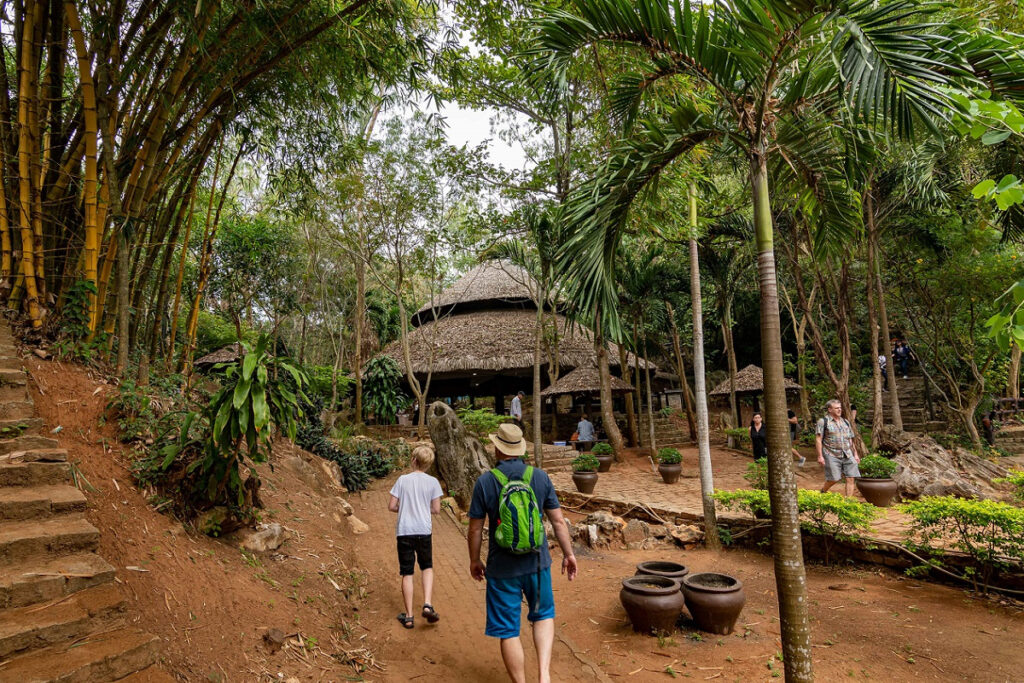
Restaurants in the Marble Mountains
SC Restaurants and Bar
Location: 152 Huyen Tran Cong Chua St-Opening hours: 7:30 a.m to 10:30 p.m-Contacts: telephone number (+84) 777333369, Email (sonle.vn39@gmail.com), Facebook (@SC.Restaurant.Bar).
Near Gate 2, this small restaurant caters a western food menu and some Vietnamese snacks. For lunch or dinner, travelers can see Italian spaghetti, French fries, burgers and more to treat hunger. Additionally, there are many options of beverage also, including both alcohols and non-alcohols to enhance the taste. Its seatings are under the shade of an umbrella on the outside or in a cozy atmosphere in the interior.
Laluna Bar&Restaurant
Location: 187 Huyen Tran Cong Chua St-Opening hours: 9 a.m to 11 p.m-Contacts: telephone number (+84) 905787337, Facebook (Laluna Bar&Restaurant).
Short walk from the elevator, this family-run restaurant serves a lunch menu in which travelers have many selections of delicious food to choose from. All come to the table with a good portion and affordable price. Bread and pancake are from 40.000 VND, noodle soup and salad from 50.000 VND, fried noodles from 55.000 VND, and spring rolls are from 60.000 VND and seafood or beef in tomato sauce from 70.000 VND. The beverages, soft drinks, fresh juices, smoothies, local beers, coffee and tea are available to pick too. The owners here don’t mind if their guests leave the bike in their restaurant to sightsee the Marble mountains. Should bring a lock.
Hung 68 Food and Coffee
Location: 110 Truong Sa St-Opening hours: 7 a.m to 10 p.m-Contacts: telephone number (+84) 905123155.
350 meters away from the foot of the Marble mountains, the food menu in Hung 68 Restaurant is limited but dishes shown on its pages have nice flavors. The list includes only two options, Pho noodle soup (50.000 VND) and fried noodles (from 70.000 VND). Water, soft drinks coffee, energy drinks, local beers, tea and traditional coffee can be found also, with a price ranging from 10.000 to 35.000 VND. Here, there are some plastic tables put in the pavement and a couple of ones inside. A peaceful sandby beach is a short distance from its front.

Festivals in the Marble Mountains
Quan The Am Festival
Festival of Quan The Am or Lady Buddha is the biggest traditional celebration in Da Nang. It annually takes place on the 19th day of 2nd lunar month (the birthday) in Kim Son, the hill to the southwest of main tourist draw Thuy Son. This religious event was initiated by Thich Phap Nhan monk who discovered a rock formation with a similar shape to the Lady Buddha by mistake in the 1950s. After that, Buddhists come to the sculpture for praying, especially in the days the Buddha was borned and came to heaven. In 1956, the festival was held for the first time and quickly drew millions of people. In 1991, its duration was extended up to 3 days to allow pilgrims in far distance to attend it easier.
Nowadays, Quan The Am festival includes many featured ceremonies and exciting activities. The earliest ceremony is Khai kinh two days before the main day. In which, the monk host asks for permission of Buddhas to hold the event and pray for peace, good weather and stable society. In the evening of the day after, a light procession occurs, featuring creative colorful lanterns and traditional dancings. In a nearby river, lighting candle lanterns are dropped down. In the main festival time, the procession takes place once again, for the Lady Budha veneration. Not only on roads, it can be seen on the river, to pray for fisherman safety and good luck.
Vu Lan Festival or the Wandering Soul Day
Yearly, the Wandering Soul festival is held in the middle days of the 7th lunar month at Am Phu cave. It aims to commemorate dead persons, especially those who die before the day specified by the King of Hell and have to go around the earth to seek food for living. In the right time, they “officially” come to the next world. In addition, for many people, this event is an opportunity to remind them about their lost father and mother. Therefore, Vietnamese people call it Parent day. Buddhist temples are their place to visit and pray. Local government also celebrate to pay tribute to national martyrs and heroes.
Death Anniversary of the Sculptor Ancestors
To honor the merits of those who initiated carving craft, local sculptors living around the foot of the Marble mountains arrange a commemoration yearly. It takes place on the 16th day of the third lunar month in the Ancestor temple by the Wood mountain. If possible, plan to attend and know more about the culture of local people.
These are tours and experiences to the Marble Mountains that you may be interested in:
If need a local guide who introduces you every side of the Marble Mountains or Da Nang generally, text us in whatsapp number +84968009827.
See also:
The Marble Mountains on Google Maps
Related Posts
Non Nuoc Beach: The Famous Beach of Da Nang
Besides the Golden hands bridge – a global hit, Da Nang city also has beautiful beaches. If looking for somewhere great to stay and have a slow holiday, Non Nuoc
How to Get from Da Nang to My Son Sanctuary
Known as ‘the Angkor Wat of Vietnam’, My Son sanctuary boasts of its sophisticated temples dating back from 4th century. Sadly, in 14th century, it’s abandoned in the forests. Today,
Bach Ma National Park: Hiking, Trekking in Da Nang and Hoi An
Two best places for trekking and hiking in and near Da Nang are Son Tra mountain (peninsula) and Bach Ma national park. Which one is better is actually personal because these
Am Phu Cave (Hell Cave) – Things to Do in Da Nang
Although in the Marble mountains – the most visited attraction in Da Nang, travelers often miss Am Phu cave. One of reasons is that it’s mentioned much online and not
Asia Park and Sun Wheel in Da Nang (Sun World Da Nang Wonders)
Have you ever seen the wheel of Da Nang? That is the Sun Wheel. It’s a part of greater Asia Park – an amusement park with a heap of fun
How to Get to Golden Bridge from Da Nang
The Golden Bridge (aka the Golden Hands Bridge) in Da Nang is a must visit attraction in Vietnam today. Many foreign travelers come to the city, just because they love
Da Nang Food Specialties: What to Eat in Da Nang
Da Nang is known as a food capital of central Vietnam. This city boasts many yummy dishes, prepared by distinctive recipes and some of them are famous all over the
How to Visit Golden Bridge Vietnam
The Golden Hand Bridge of Ba Na hills today is a dream place to visit for many travelers. Since it opened in June 2018, millions of people have set their
Da Nang Shore Excursions: Guided Tours From Tien Sa Port
Da Nang Vietnam today is one of stopovers for many cruises that travel from continent to continent, from country to country. It owns an ideal seaport to moor and it
Han Market (Cho Han): Where to Shop in Da Nang?
In the heart of Da Nang, the Han market is a popular place for visitors to buy something to bring home due to the diversity of merchandise. Back to history,
Da Nang Cathedral (Da Nang Pink Church)
Da Nang became a French protectorate on 3rd October 1888, under the name “Tourane”. By the Han river, the colonists designed a grid of streets with public buildings, a city hall,
Things to Do in Ba Na Hills Besides Golden Bridge
According to local authorities, 50% of visitors coming to Da Nang and Hoi An visit the Ba Na hills. In other words, that is nearly 10 millions of people. This
Da Nang Half Day Tours
In addition to day trips, travelers have many options of half-day tours in Da Nang to choose from. Not to spend a full day at different places, maybe far from
Da Nang Private Car and Driver
Your next holiday destination is Da Nang? You prefer to travel by yourself? Hiring a private car is one of the best options for you to explore with freedom, flexibility
Da Nang and Hoi An Itinerary for Visitors Staying Overnight in Hoi An
Da Nang and Hoi An are twin cities in the heart of Central Vietnam. Both are popular tourist destinations for either domestic or international visitors, and share many similarities. Due
Da Nang Things to Do: Guide to What to Do in Da Nang Vietnam
Unquestionably, Da Nang deserves a holiday trip from all types of traveller. Firstly, due to the weather. It has a longer sunny time than the north but less hot than
Da Nang Best Things to Do and Reasons
Da Nang is the largest tourist center in Central Vietnam. It owns fascinating natural and cultural places that attract both Vietnamese and foreigners. In the busiest year, this city of
How to Get From Hoi An to Da Nang
Da Nang is the neighbouring city of Hoi An. It's the capital of Central Vietnam and has the most important (busiest) transport hubs of the region, such as airport, train
Hoi An or Da Nang: Which is Better for First Time Visitor?
Da Nang and Hoi An are located in Central Vietnam, with a distance of roughly 30 km. To the north, Da Nang is the capital city of the region, with
My Son Sanctuary Tour
My Son Sanctuary is a Unesco world heritage site, attracting 450,000 visitors in recent years. It’s the best remains left by the fallen Champa Kingdom which ruled a part of
Da Nang Best Area to Stay: Guide to Where to Stay in Da Nang
In the Central coast, Da Nang has an area of 1,285 km2 and population of 1,134 people, making it become Vietnam’s 4th largest city. It plays an important role in the
Da Nang Cave Tour: Best Underground Activities in Da Nang
Different from Hue and Hoi An, Da Nang has limestone caves and grottoes. All of them are within the Marble Mountains (Ngu Hanh Son), a complex of 5 amazing hills
Da Nang Best Time to Visit: Guide to Best Weather in Da Nang
Da Nang is titled “Asia’s leading festival and event destination” by the World Travel Awards or Vietnam’s greenest city by the WWF. Its reputation comes from amazing natural mountain-to-sea sceneries,
Da Nang Weather by Month: Guide to Monthly Weather in Da Nang
In Central Vietnam, Da Nang has a tropical monsoon climate with two distinct seasons that each starts later than the North 2 months. Because of being shielded by the spectacular
What to Do in Da Nang At Night
Between the sunset and midnight, there are many things to do in Da Nang that travelers should know before getting to bed. Thankfully, different styles of traveling, budget or ages
Lang Co Vietnam Travel Guide
Lang Co was a lovely backwater town nestled at the foot of spectacular Hai Van Pass for some decades. Not yet widely known because of the popularity of beaches in
What to Do in Da Nang for 3 Days
Da Nang is a lovely coastal city in the middle of 3 Unesco world heritages Hue, Hoi An and My Son Sanctuary. This most worth-living municipality owns a poetic river
My Khe Beach: A Complete Guide to Da Nang’s Best Beach
Da Nang is a lovely seaside city with many beaches, and the best is My Khe. Located on the eastern coastline, it’s between little-known beaches near the foot of Son
Da Nang Day Trips: Guide to Best Day Tours From Da Nang
Centre and outskirts of Da Nang have incredible attractions where travellers need to spend many hours to get to and fully explore. There are the Ba Na Hills and Golden
Museums in Da Nang
Da Nang has many museums where visitors can see and learn a lot. Generally, their exhibitions have different themes, varying in stages of the history, groups of people (communities) having
Linh Ung Pagoda: Trio of Da Nang’s Holiest Mountain Temples
Linh Ung means “wishes answered miraculously” in Sino-Vietnamese. And it’s first used in 1841 to name a pagoda in the Marble Mountains by Thanh Thai, the 10th king of the
Da Nang Night Market: A Thing To Do in Da Nang at Night
Different from day markets in Da Nang, night markets are held open-air and on streets where traffic is active during sunny hours. A visit there provides the chance to understand
Guide to Son Tra Mountain (Monkey Mountain) in Da Nang, Vietnam
From My Khe Beach or Han River promenades, tourists can see a part of the Son Tra Mountain. Although being near the city center, natural forests on its slopes have
Ba Na Hills Tour
Ba Na Hills is one of the best attractions in Da Nang, and the country. Its full name is the Ba Na-Suoi Mo Tourist Area, made from “Ba Na hill
Da Nang Cable Car
No surprise that now, when travelers make the plan to tour around Vietnam, there are many cable car rides recommended. Some are top things to do in its cities. The
How to Get from Da Nang Airport to Hoi An
Located in the city of the same name, Da Nang airport is the nearest airport to Hoi An. So, if travelers want to see an extremely-colorful Lantern festival or try
Da Nang to Hoi An: Best Da Nang Airport Transfer and More
If traveling to Hoi An by air, train and cruise ship, visitors will come to Da Nang first and then have a transfer. The largest city of Central Vietnam holds
Hai Van Pass Da Nang: Map, Route, Weather, History, Tour
Truong Son or Annamite Range is the most dramatic mountain ridge in Vietnam. When it juts out into the sea, spectacular Hai Van Pass is formed. This amazing sculpture of
Da Nang Attractions Guide: What to See in Da Nang Vietnam?
Da Nang is the capital city of the Central region, and one of the most attractive destinations to tourists in Vietnam. It’s established by French colonists and called by them
Guide to Lady Buddha (Goddess of Mercy) in Monkey Mountain, Da Nang
From the East coast, visitors can see an enormous white statue with the mountain backdrop, that is the Lady Buddha Da Nang. Located in the ground of Linh Ung Pagoda,
My Son Sanctuary Travel Guide
My Son Sanctuary is a complex of Hindu temples and a Unesco world heritage site from 1999. It’s 40 km away from Hoi An and 70 km to the southwest
Da Nang Museum of Cham Sculpture
Da Nang Museum of Cham Sculpture is a highlight of the Han river waterfront. It’s established by French archaeologists to preserve intricate works of art of Champa kingdom, which ruled
Dragon Bridge Da Nang: The Fire-Breathing Da Nang Bridge
Praised to be the world's 30 most unique bridges recently, Dragon Bridge became the new icon for a Han river bridge in Da Nang. Spanning from the 100-years-old Cham Museum,
Ba Na Hills Travel Guide: A First Timer’s Complete Guide
50% of visitors to Da Nang plan to visit Ba Na Hills in their itinerary. It’s larger for first timers who may know about its inspirational Golden Bridge, world-record cable
Golden Bridge Da Nang: A Guide to The Iconic Da Nang Bridge
Recently-built but at the present time, the Golden Bridge Da Nang is one of the awaited attractions in Vietnam. On a slope of high foggy mountain, this delicate bridge and
Da Nang Bridge: A Guide to Famous Bridges in Da Nang
Da Nang has many bridges, and some of them are famous nationally and internationally. Before the recently-built Golden Bridge which made a boom in social media, people only knew bridges
Ba Na Hills Cable Car: World Record, Cost, Reschedule, Map
Cable car is one of the first ideas travelers think about Ba Na Hills, a Da Nang’s top attraction. It helps to shorten the time to get to the hills
Da Nang Mountain Temple: Marble Mountain’s Pagodas, More
Da Nang has many mountain temples where handmade architecture, natural sceneries and religious values are combined perfectly. So, travelers will see, enjoy and learn a lot about different things just
Da Nang Caves: Underground World of the Marble Mountains
One of the priceless gifts Mother nature gives to Da Nang is an array of caves and caverns. Almost all are located in the Marble Mountains, a complex of
The Marble Mountains: Guide to Da Nang’s Iconic Mountain
Had been an offshore group of islands, geological activities shifted the Marble Mountains to the land some thousands of years before. Today, its marble hills rise suddenly up to over 100






